
- Skin on Frame
- Viking ship Draken Harald Harfagre

Photo by Silje L. Bakke One of the inspirations of my little Skerry was the Norse Faerings. The word Faering refers to the four oar stations. It merely means a boat with 4 oars. In the same way a treroring has 3 rowing in the boat.There are also larger and smaller row boats in the same tradition.
Different areas have variations of faerings, but they all have 4 oars in common.
A faering is a clinker (lapstrake) type boat which is pointed at both end, with no transom. The strakes, which are often cedar, pine, spruce, or larch or other similar wood, are attached to a backbone which is composed of a curved stem and stern which attach to the keel. The backbone is often white oak or other strong rot resistant wood. The overlapping strakes were held together with rivets. In most cases the rivets were iron with washers. In some cases there were no washers and the rivet/nail was trimmed and hammered till it formed a j and the point embedded itself back in the strake. The boat is built and the strakes are laid then the ribs are added. Modern boats usually use copper rivets and washers.
Faerings have ribs which were made from curved planks often a side branch would be kept on the stem and this shaped to make ribs. The side boards or strakes were traditionally made from solid wood. Spruce or pine are common as is larch (tamarack). More rare are oak strakes. If boards were too short they were scarfed and the scarf fastened with rivets. The stem, stern, and keel were preferably made of a harder wood often Oak. Many different types of wood are used depending on what is available in the area.
Vikingship.com has a nice article on Faerings with lots of photos. It's well worth visiting the site.
New faering on it's maiden voyage. It gives a good idea of how the boat feel in the water. Here is the address in case it does not show up. youtube video
There is a fabulous wooden boat forum thread on building an Oselvar. This is boat porn at it's very best. He is using traditional materials and methods. The result is very lovely.
Although solid wood is the traditional way of building faerings, modern designers have successfully used marine plywood. Ian Oughtred's Elf is a faering designed for plywood. In this example the Elf faering has been adapted back to solid wood construction.
In the beginning the strakes were made from wood that was split rather than cut, then when sawmills were built around the 1600 the strakes were cut.

Oselvar are found on the west coast of Norway. They are often fitted with 2 sets of oars so can be called faerings.They are popular boats and are raced.
The Oselvar is a candidate for the first kit ever built and sold. From the 1500 to half way in the 1800s these boats kits were exported to the Shetlands and Orkney's. (These island were lacking large trees and could not produce the lumber needed to make boats at home.) Once safely delivered they were assembled. and finished. It has a long history as a work boat, but also has been used as a pleasure boat for several generations.
Faerings were the everyday work boat in Scandinavia and were used to transport people in a land with many island and fewer roads. They were also used for fishing and moving stuff around. Now there are several organizations racing traditional boats.
The beautiful lines of the faerings have inspired designers to adapt the design for more modern boat building methods. If you are interested look up Iain Oughtred.
Faerings are often fitted with sailing rigs. Sprit rigs are commonly used as are other square sails. When a faering is intended to be sailed a rudder is fitted. The push pull type of rudder is the traditional choice of old time boat builders. It takes a bit of getting used t but has the advantage of leaving the back free and uncluttered.
Faerings, like other boats pointy at both ends, can handle rough water. The narrow ends don't fill up with water when there is a breaking following sea.
- Ultralights
- Boatbuilding Links

Faering Links
Small print.
I don't claim to be an expert in faerings, I'm a fan though. If you want to build one do your homework first.
- Accessories
- Built Boats
- Information
- Rowing Boats
- Sailing Boats
- Motor Boats
- Surf and Paddle Boards
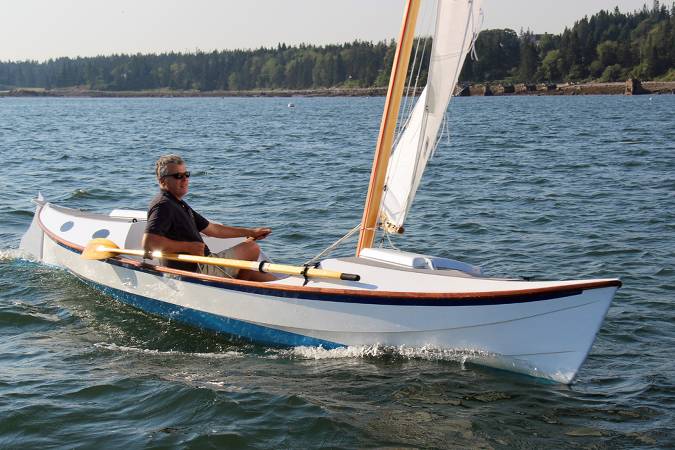
Faering Cruiser
Hull kit £4766
PDF study plans £3
Eco epoxy upgrade +£20
Offer Details
The shopping basket requires JavaScript to be enabled in your browser.
Quantity : Add to Basket
Added to Basket
Prices include VAT
Product Description
A serious rowing and sailing boat for coastal cruising, with a small cabin aft. It is a functional boat combining modern building methods with a traditional stylish clinker hull shape.
Faerings are the indigenous smallcraft of Scandinavia, direct descendants of the Viking ships that raided and traded throughout Europe starting more than a thousand years ago. Light but strongly built, the distinctive double-ended hulls feature a sweeping sheer-line, lapstrake planking and a narrow waterline for speed under oars and sail.
The traditional faerings were, like the Viking ships, built by fastening overlapping lapstrake planks together with rivets and then adding internal frames for strength. This Nordic boatbuilding method produced lighter boats than the more common method of building a frame and then covering it with planking. The elegant hull shape of the Norwegian faering adapts well to the modern stitch-and-glue method, in which pre-fabricated plywood panels are joined at their edges to create a light and stiff hull with minimal framing.
Boat designer John Harris created a 19′8″ stitch-and-glue faering for beach cruising with one or two sliding-seat rowers. Four of them have been built, but unfortunately there hasn't been time to create the elaborate instruction manual that would make construction accessible to amateurs. However, John used it as the basis for the Faering Cruiser, a longer boat with a small cabin and a sailing rig but still with enough space amidships for a sliding seat rowing rig.
The hull, cockpit and interior framing is mostly 9 mm Okoume plywood and the decks are 6 mm Okoume plywood. With the pre-cut panels in the kit, assembly is very quick. CLC's LapStitch process yields a hull that is stiff, light, beautiful and quick to build.
While 22′6″ of overall length sounds big, this is actually a fairly compact camp-cruiser, weighing only about 650 lb on the trailer. It tows effortlessly behind small cars.
The cabin is comfortable, if cosy; similar to sleeping in a good one-man tent. The advantages over an open boat are that your gear and bedding stay dry no matter what the weather's doing, the sealed compartment provides a great deal more safety in a capsize and you have lockable stowage.
Several rig options were considered before settling on a single balanced lug sail. The sail area is modest, but the hull is very easily driven. The boat is fast, jumping up to 6 knots in 12 knots of wind. 270 lb of water ballast beneath the self-bailing cockpit floor settles the boat right down, though a reef is needed once whitecaps appear unless you're trying to win a race. The pivoting centreboard allows nice balance and excellent upwind ability. The rudder is connected to the tiller with stainless steel cables that run through baffled vents in the cabin (no leaks to worry about). Flipping the tiller up locks the rudder on the centre line for rowing.
With a sliding seat and long sculls, a rower of modest strength and ability can move the boat upwind easily enough, although you're likely to be sailing if there's a long way to go to windward. In a flat calm, it's easy to imagine a 25-mile day under oars alone. We might consider eliminating the sliding-seat option and using shorter oars with a fixed seat. Speed would suffer a little, but there would be no need to stow a sliding seat and oar storage would be improved. Lazy jacks lift the furled boom and yard to clear the cockpit for rowing. A tabernacle scheme for lowering the mast is suggested, but it's fairly complex and will add weight.
As a coastal cruiser, this design offers many advantages: a dry berth, lots of storage and excellent speed under sail and oars. We suspect that many builders would be moving up to this design from kayaks or small rowing boats, seeking more comfort and stowage while maintaining a small footprint on the coastal trail.

The hull kit includes:
- Pre-cut wooden hull panels with pre-cut puzzle joints and pre-drilled tie holes
- Rudder, centreboard and centreboard case
- Solid timber stock for rails, stringers and cleats
- Epoxy resin and activator
- Epoxy fillers
- Copper ties
- Woven glass fabric
- Woven glass tape
- Plans suitable for experienced builders
- Free technical support from a competent builder
Hardware, rowlocks, sliding seat hardware, spars, sail and rigging are not included in this base kit package. This boat is designed for use with a sliding seat, the parts for which are not included in the kit.
What else do I need?
While the kit will go together quickly for someone who can read plans and has some experience building larger-scale wood-epoxy composite boats, this is not a project for first-time boatbuilders.
This kit weighs a lot and requires a specialised courier. The price of delivery will vary with your address. You are, of course, very welcome to collect the kit from our Lake District workshop.
Plans (not required by kit purchasers)
The plans contain sufficient information to build the boat from scratch rather than a kit. Despite the stitch-and-glue construction method, the Faering Cruiser is not for first-time boat-builders. Professionals and experienced amateurs will find it a fast and straightforward build, but you'll need to have good plans-reading ability and a couple of wood-epoxy composite boats under your belt before diving in.
The plans include 17 pages of architectural drawings and full-size templates for every part in the boat except the hull planking and decks. There are pages devoted to the rigging of the tiller, hatches and other peculiarities of the design.
PDF study plans
An 8-page set of study plans in PDF format that can be viewed using Adobe Reader. After credit card authorisation the file will be sent to the email address put on the order form. Nearly all details are shown, providing a good overview of the boat and it's construction.
These study plans are intended for pre-build study or to help with the decision to purchase. It is not possible to build the boat from scratch using only these plans.

European Manufacturers for Chesapeake Light Craft
This boat is also available ready-built .
Recommended Products
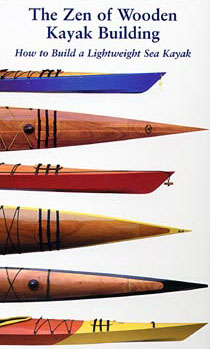
Boatbuilding DVD
How to build a lightweight boat (not just a kayak).
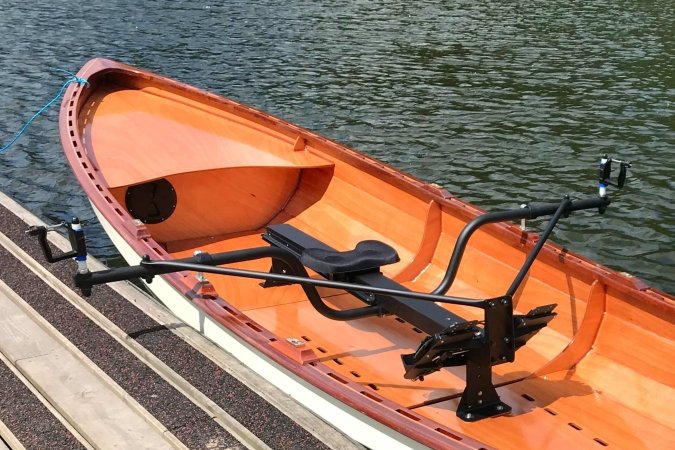
Big River Rowing Frame
A drop-in sliding-seat rowing frame for sculling boats and canoes.

Carbon Fibre Sculling Oars
Light weight carbon fibre sculling oars with fibreglass blades in the hatchet (cleaver) or Macon shape.
- Fyne Boat Kits — Old Cooperage Yard, Gatebeck, Kendal, Cumbria LA8 0HW
- Telephone: +44 (0)1539 567 148
- Email: info [at] fyneboatkits.co.uk
Copyright © Fyne Boat Kits
March / April Issue No. 297 Preview Now
Of Færings and Fembørings
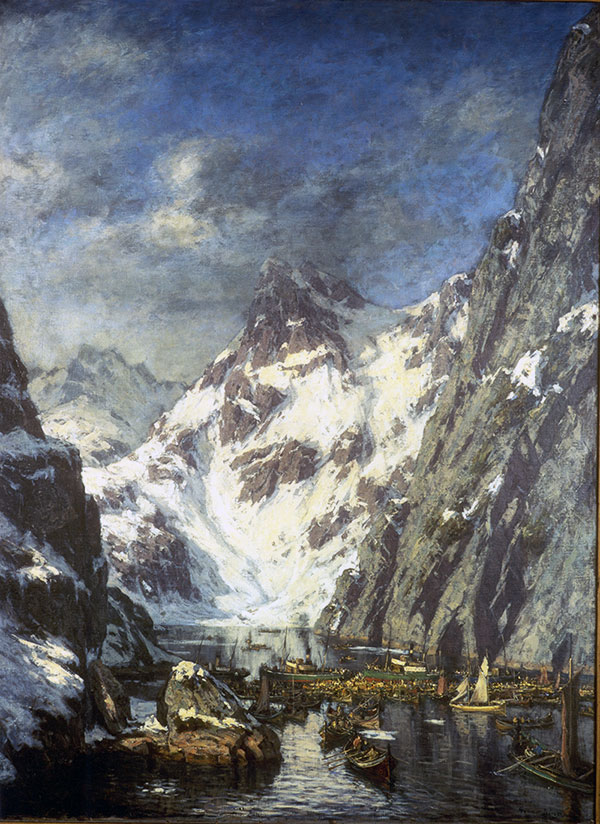
The Battle of Trollfjord, painted by Gunnar Berg
This article is a sidebar of Arista Holden’s article “The Last of the Vikings” about her experiences at Fosen Folk School in Rissa, Norway published in WoodenBoat magazine No. 261, March/April 2018.
For such a small country, Norway has a rich variety of traditional small boats—each one adapted to its particular region. And within those regions, there is further variety based upon the whims and styles of the builders.
Færings are among the best-known small boats in the country. They are propelled by two pairs of oars, which is what gives them their name: in the Old Norse language, it means “four oaring.” The færings of southern Norway tend to have curved, raked stems and are more heavily built than their plumb-stemmed, lighter cousins in the Nordland and Afjørd regions.
A fembøring has proportions and appearance similar to those of a færing, but it is larger, and driven by a squaresail in addition to oars. As mentioned by the main article’s author, Arista Holden, fembørings have distinctive cabins in the stern. These were built to be removable, and typically used for crossings from the mainland to the Lofoten cod grounds, and then carried ashore for land-based lodging, to make room aboard for fishing gear.
By 1890, the writing was on the wall for the open-boat Lofoten cod fishery. That year, a massive fleet of færings and fembørings encircled a fleet of industrial steam-driven vessels in an attempt to ban their access to the 2km-long (1.24 mile) Trollfjord. The incident is recorded in a painting by the Norwegian artist Gunnar Berg, who hailed from the Lofoten municipality of Svolvær.
You can experience a sampling of Norwegian small boats in the Boat Hall of the Norsk Sjøfartsmuseum in Oslo, which has, in addition to many other boats, a rigged fembøring on display. And the book Inshore Craft of Norway , edited by Arne-Emil Christensen from a manuscript by the Norwegian boat archaeologists Bernhard and Oystein Faerøyvik, is the standard introduction to the country’s small-boat types. —Eds.
Purchase this issue from the WoodenBoat Store
ACCESS TO EXPERIENCE
Subscribe today.
Publishing dynamic editorial content on boat design construction, and repair for more than 40 years.
1 YEAR SUBSCRIPTION (6 ISSUES)
Print $39.95, digital $28.00, print+digital $42.95, from online exclusives.
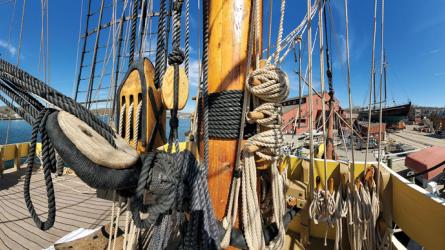
MAYFLOWER II’s Rebirth
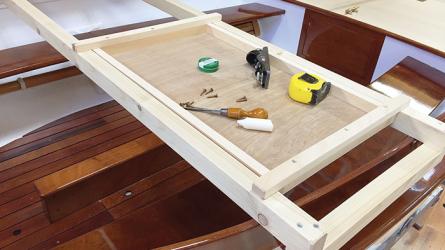
A Sliding Tool Tray
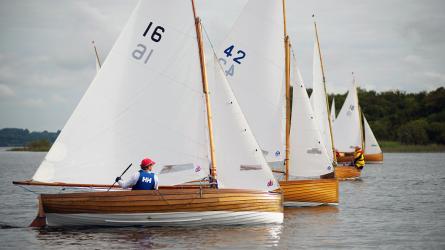
Ireland’s Water Wag
Extended content.
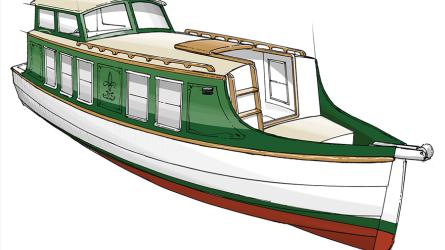
From the Community
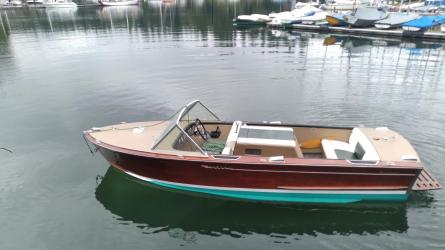
'66 Century Resorter 17
Mahogany inboard. New varnish & bottom paint. Newish 383 (500-hp). 50 mph. New upholstery.
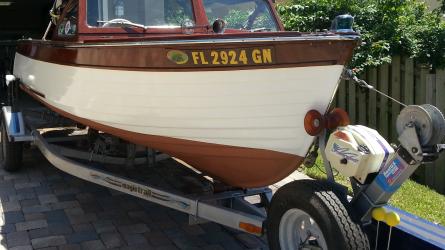
1959 THOMPSON 17’ RUNABOUT – PRICED TO SELL!
Pre 1905 Warren Cole Adirondack Guideboat LOA 16′, 42″ beam
Restored in ME by Jonathan Minott (seen in WB "Launchings" July/Aug 2009).
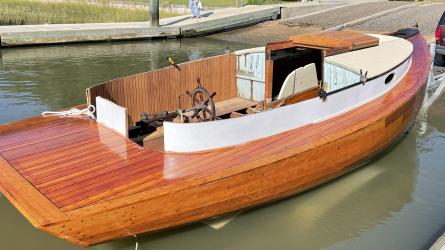
Vintage Crosby Catboat - I Belong in a Museum
Partial restoration. Has rare Edson oscillating (worm) steering system.
I have been a recreational sailor for many years, with a particular interest in small sailing craft; therefore much of the content of my 'blog' will be related to this subject.

Saturday, December 05, 2015
Faering cruiser.

2 comments:
Hi Bill, the Faering is a lovely boat indeed. John Welsford has a new design, slightly shorter 18', called Long Steps. Thought I would post a link in case you had not come across her yet. Design and build are just beginning, and John blogged about her here. http://jwboatdesigns.blogspot.co.nz/2015/10/the-new-boat-design-and-first-piece-of.html I think she is very well resolved indeed. Elements of Scamp and Walkabout combined in a larger boat for coastal cruising. I could so see her moored on the sea wall by the River Wardens office at Keyhaven, all ready to slip away with the incoming tide into the Solent or away with the ebb to Poole and beyond. Can you tell I like her a lot Bill?
Thank you very much indeed, Brian. I think John has come up with a winner! Already a lot of interest is being shown by the small sailboat/boatbuilding community. With the combined elements of Scamp and Walkabout she'll be a more able boat than either of them, capable of undertaking longer coastal passages. She'll sail fast, and being self-draining she'll be able to take a bit of stick. As is the case with many a sailboat adventure, much depends on the ability of the crew. John aspires to sail her around NZ's North Island before he gets too old to so. Good for him! Armchair sailor that I have become, I'll be looking forward to hearing how he gets on. I wish him all the best. Brian, I can see why you like the boat - perfect for Keyhaven and Solent sailing. Cheers, Bill.
Post a Comment
Wooden boat builder, Boat for sale, power, sail, classic, modern, custom, yachts, dinghy, sailboat, motorboat, powerboat, commuter, sea, lake, river, Ireland, Cork, UK, England, Scotland,Wales, Europe Roeboats
Classic wooden sail and power boats custom built in ballydehob, west cork, ireland, 16′ faering.

These four boats were built for two different Viking era type TV productions. The first ones were built (2012) for Game of Thrones and feature large ceremonial stem and stern ornaments. They were built as funeral boats for a major scene. The other more “conventional” ones were built for Vikings (2013) and were to be used as general boat transport for various characters.
Based roughly on the traditional Faerings or four oared boats of the Hardanger region in Norway and heavily influenced by the small boat found at Gokstad these boats are surprising for more than their looks. They are burdensome and light, track well when rowing and are incredibly easy to row. Roeboats also made some beautiful light and strong spruce oars to a traditional Norwegian pattern for these boats. If you were looking for a light, elegant and seaworthy boat that would be at home on rivers, lakes and the sea you won’t go wrong in choosing one of these. Roeboats can custom build these in a variety of lengths up to about 20′. If you prefer they can have either the swept up planking or not.
Specification: 16′-20′ Length overall 4’6″ Beam 6″ Draught 9′ Oars (two pairs as standard)
A sailing version is also available. Give Tiernan a ring +353 28 38973 to discuss having your Viking longboat built so you too can go raiding and pillaging.
P.S. The photo of me lying down in the boat was as a stability test. Really I wasn’t catching forty winks after 3 weeks toiling away in the workshop night and day.
Roeboats , Ballydehob, Co. Cork, t:+353 (0)28 38973 m: +353 (0)86 158 69 37 e: [email protected]

- Already have a WordPress.com account? Log in now.
- Subscribe Subscribed
- Copy shortlink
- Report this content
- View post in Reader
- Manage subscriptions
- Collapse this bar
From The Editor
A Magnificent Clutter
From Issue November 2020
T he Pacific Northwest is half a world away from Scandinavia, and the Vikings never reached it on their voyages to North America, but their influence on contemporary boatbuilders did. In the ‘80s, when I began to take an interest in boatbuilding, I admired the Norse-influenced boats built by two of the region’s local builders: Paul Schweiss, who had trained in Norway and was building traditional Bjorkedal boats, and David Jackson, who built the faering that my friends Ginger Cox and Tish Davis rowed the length of the Inside Passage in 1976. The current and most prolific practitioner of Norse boatbuilding here is Jay Smith, operating as Aspøya Boats in the forested fringe of Anacortes, Washington.
For the past several years, Jay has been working with the Friday Guild: Leah Kefgen, her brother Per Brekke, Matt Fahey, Vernon Lauridsen, and Torolf Torgersen. The group, which had built the geitbåt featured in our September 2016 article “ Building on Tradition ,” is now working on a 17′ Nordford faering. The boat was documented in The Inshore Craft of Norway, and when the drawings were made in 1943, the boat was reported to be over 100 years old. When the faering is finished, it will be Leah’s “company yacht” for Best Coast Canvas , the maker of the Verksted Apron I reviewed this past spring. I’ve been keeping up on the progress on the faering through Leah’s Patreon posts and emails, and when she and Jay invited me to see the boat, I paid a visit to the boatshop on the first Saturday in September—the Friday Guild now meets on Saturdays, but kept the name. While the crew was busy installing sections of the sheer planks, Jay gave me free rein to wander around the shops and sheds.
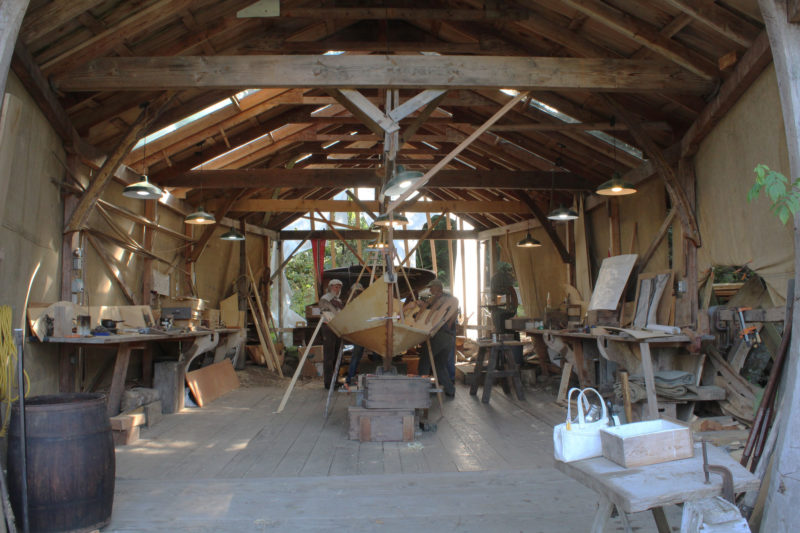
In a shed at the end of Jay’s driveway, an 18′ Nordfjord faering is taking shape. The workbenches on either side are built with diagonal braces that extend beyond the front edge of the top and have notches to hold planks on edge.
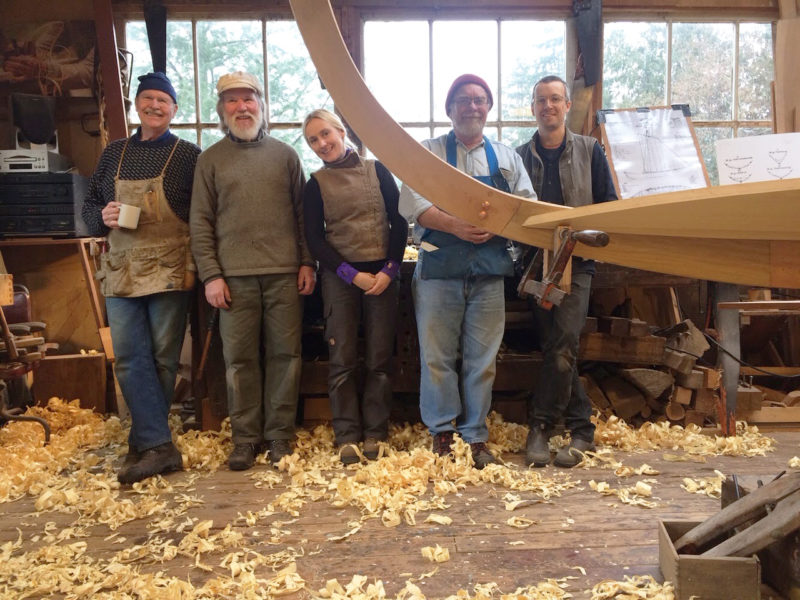
The Friday Guild is composed of, from left, Torolf Torgersen, Jay Smith, Leah Kefgen, Vernon Lauridsen, Per Brekke, and, not present here, Matt Fahey.
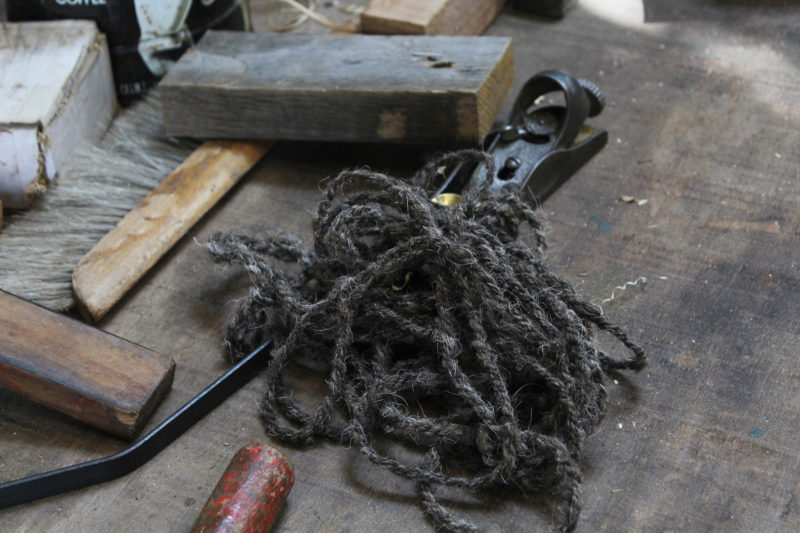
The wool yarn that goes into the laps to make them waterproof is called siggj, pronounced soy-ch, the Faroese term that Jay picked up during his apprenticeship on the Faroe Islands. The yarn is called sisnor in Norwegian, “a loose string of animal hair, well tarred, inserted between strakes before riveting.” Leah’s mother, Kristi, spun the yarn from raw fleeces from an Oregon flock of Herdwick sheep, a breed native to northwest England, the ancestors of which may have been brought by Norse settlers in the 12th century.
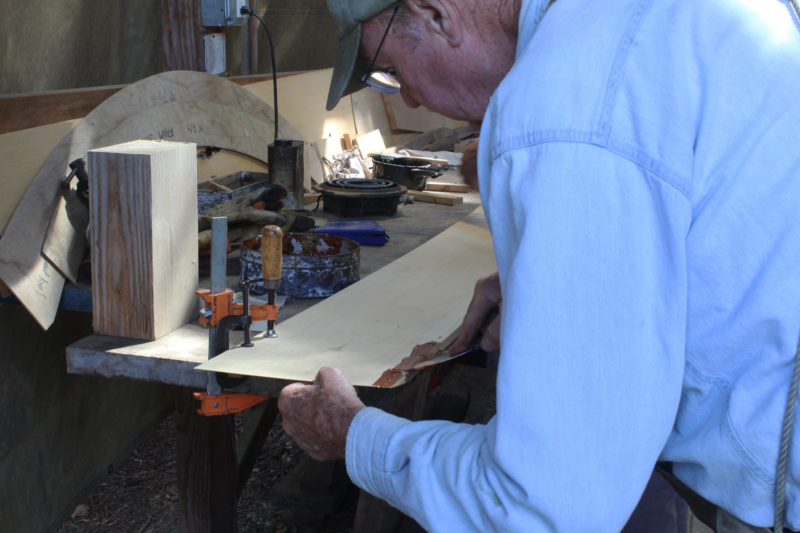
Torolf applies hot bedding compound to the sheer plank section he had been working on. It’s a mix of Dolfinite, linseed oil, underwater seam compound, and pine tar. It’s heated up in its can on the hot plate. The warm mixture is easier to spread and bonds better with the wood.
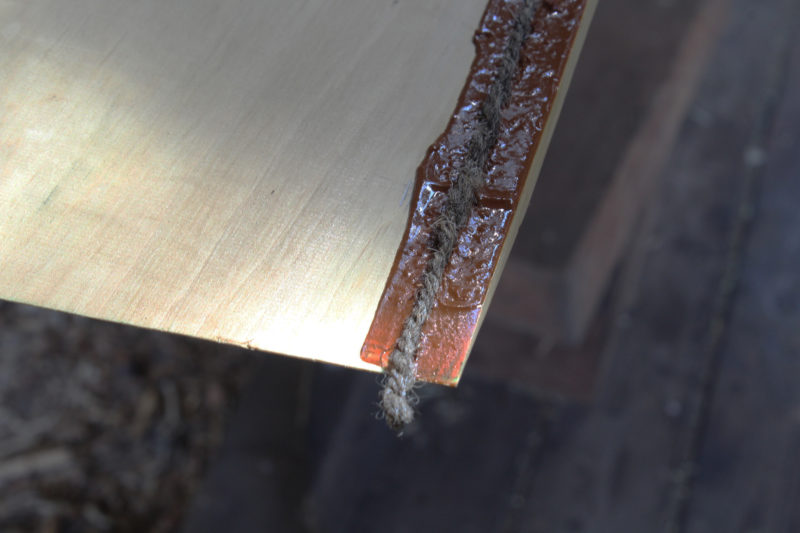
The twisted wool yarn sticks to the bedding compound to be sandwiched in the lap to keep it watertight. The lap is drawn tight over the siggj with a hollow cove, cut with a special plane, called a siggjhøvil in Faroese.
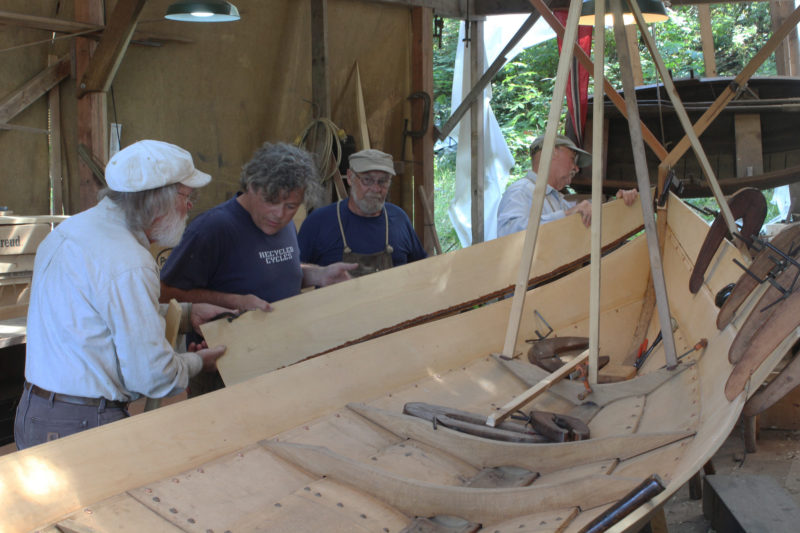
Jay, left, and Friday Guild members Matt, Vern, and Torolf bring Torolf’s sheer plank to the hull to clamp and fasten it in place. Each section of planking is made by one member of the Friday Guild rather than shared among them. It’s a traditional way of doing the work: Leah mentioned that the planks of surviving Viking ships bear several different decorative treatments, called pynt, planed or scraped along the edges by the builder who made the piece.
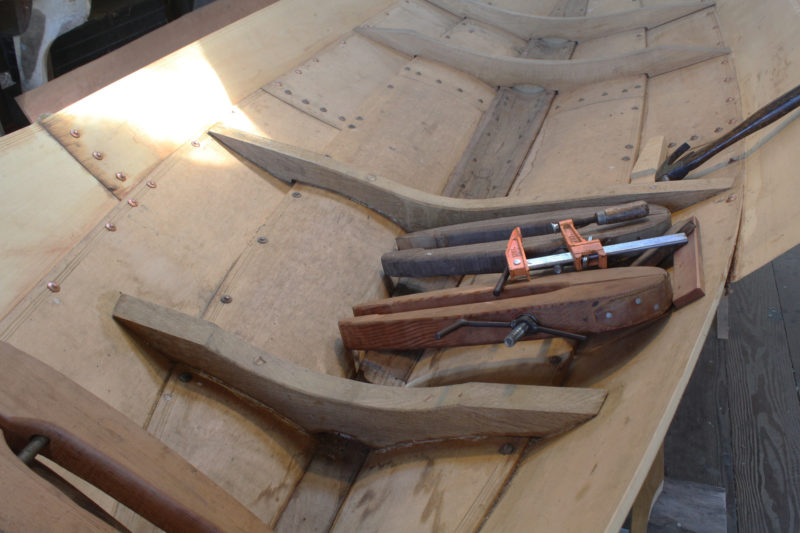
The most hard-won shapes in the faering will be hidden when the floorboards are in place. The floor timbers here reveal the curves across the width of the garboards, carved from slabs of Alaskan yellow cedar 2″ to 3″ thick. And the top of the T-shaped keel is concave, offering the garboards parallel surfaces to better hold the rivets.
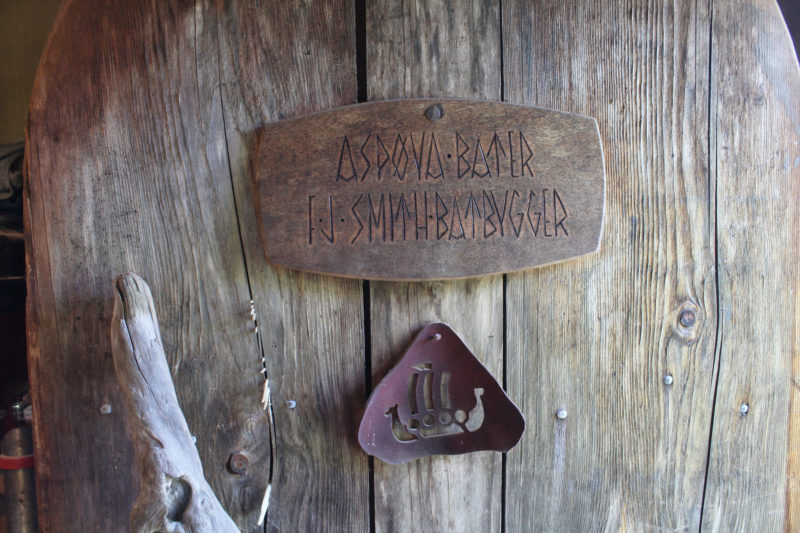
The sign on Jay’s shop door, carved by Torolf in Norwegian in runic-like characters reads: Aspøya Boats, F J Smith Boatbuilder.
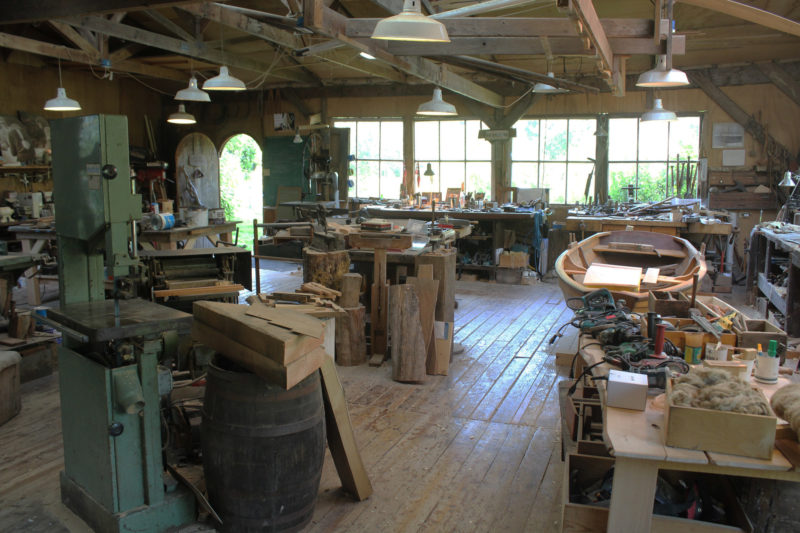
The 1,000-square-foot shop is well-lit by windows along its northwest and northeast walls. There are tools, benches, and pieces of wood everywhere, but the paths around them are clear and nothing gets underfoot.
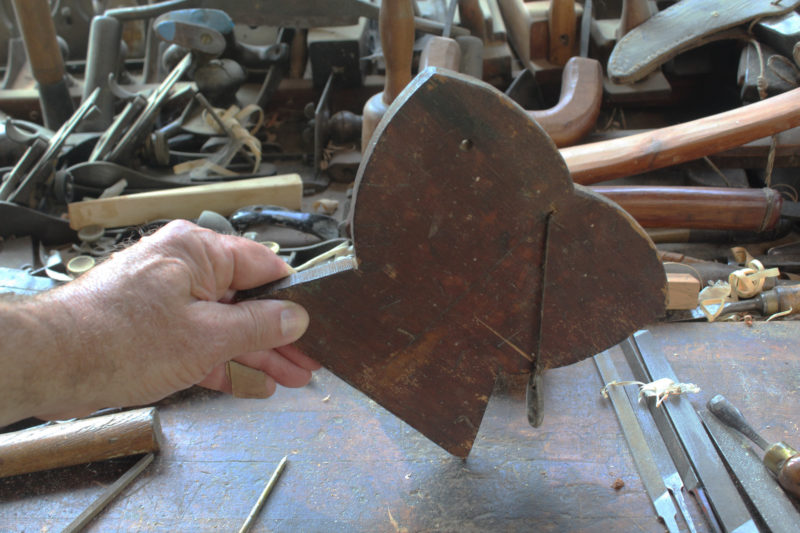
Norse boats are built upright without molds, so this device, called a båtlodd or båpasser is used to determine the lay of the planks. The small plumb bob indicates the angle, which is marked along the curved edge.
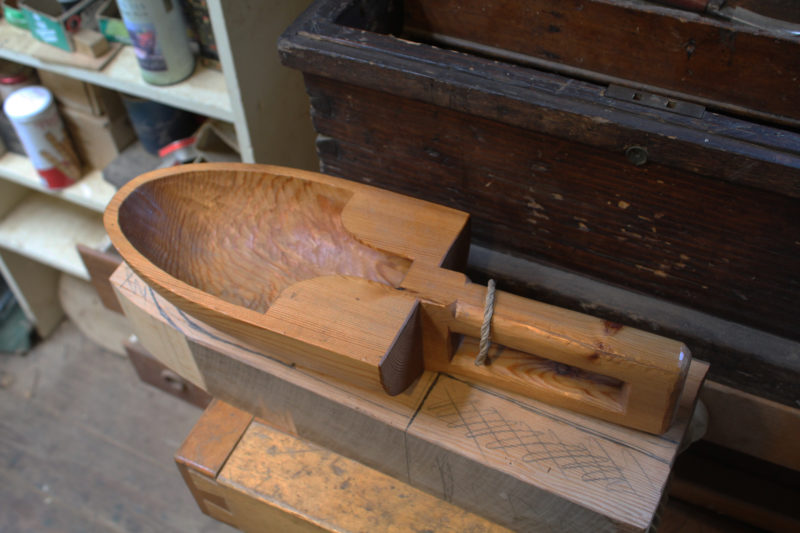
This traditional form of bailer, auskar, sitting in the shop was handsomely carved from Douglas-fir. The block it rests on has the pattern drawn on it.
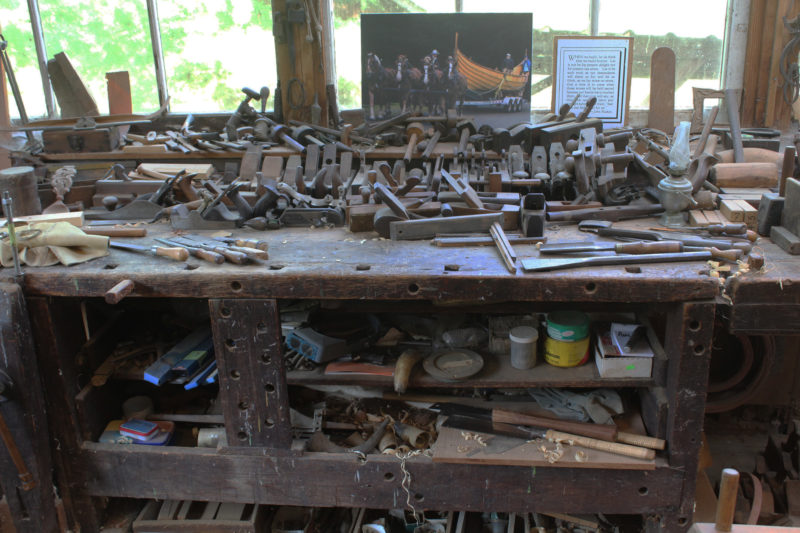
The bench on the northwest wall has, among other tools, a half-dozen spokeshaves, nine marking gauges, five plumb bobs, three radius planes, 35 wooden planes, four metal planes, two back saws, and a dozen chisels and gouges. The photograph at the back of the bench is of Jay’s 37’ POLARIS, launched in 2017.
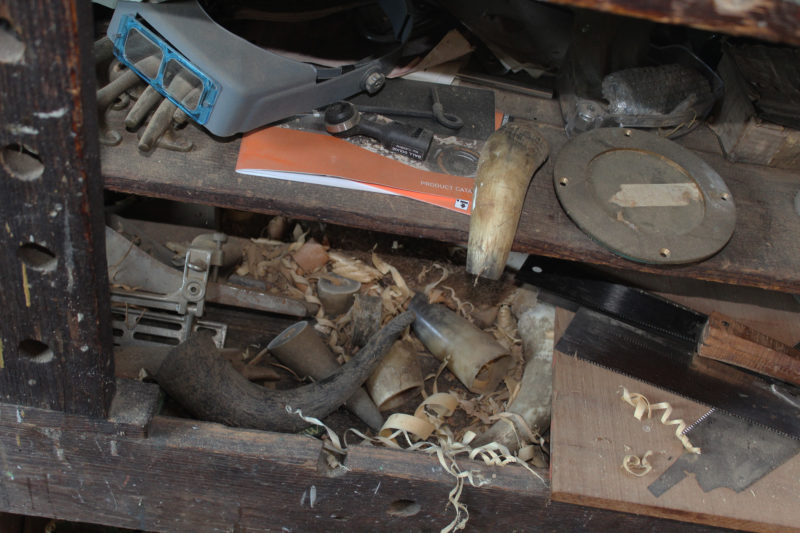
Under that bench there is a collection of cow horns. Rings cut from the open end of a horn are used with shroud needles, devices to tighten the standing rigging. The ends get used as containers for the tallow used to lubricate oar leathers.
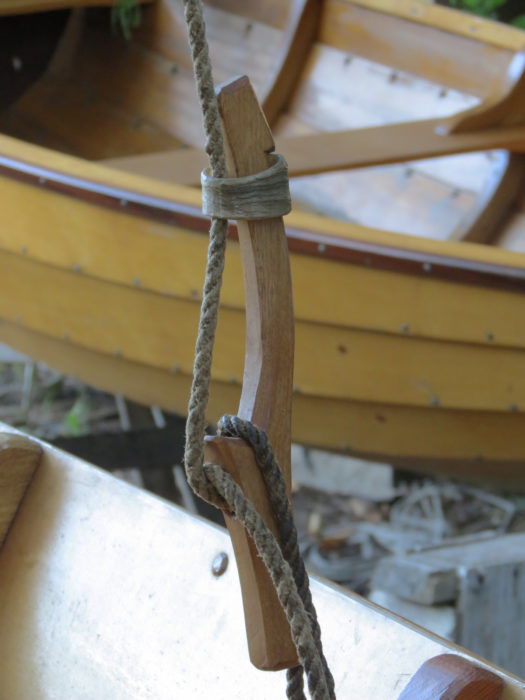
Here’s a ring of cow horn on one of the geitbåt’s shrouds.
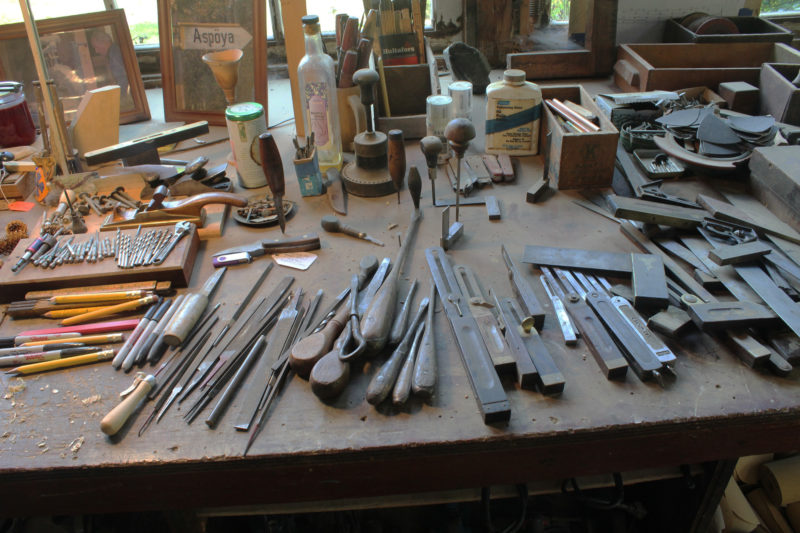
Jay’s cluttered workbenches are not without order. Here, markers, pencils, drill bits, files, screwdrivers, bevel gauges, knives, awls, and squares are all neatly arranged. I got the feeling that there was a place for everything and in time I could find my way around the shop if I needed to find a tool. The framed picture at the back of the bench is of a street sign in western Norway, pointing the way to Aspøya, the island where Jay served as an apprentice to a master boatbuilder, Nils Ulset, in the late 1970s.
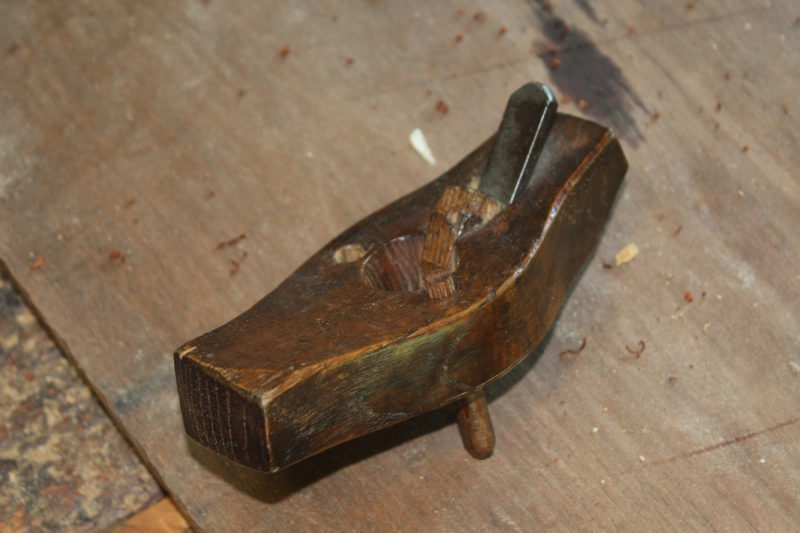
Jay made this benchmark plane during his apprenticeship in the Faroe Islands. The oak has been smoothed and polished by four decades of use.
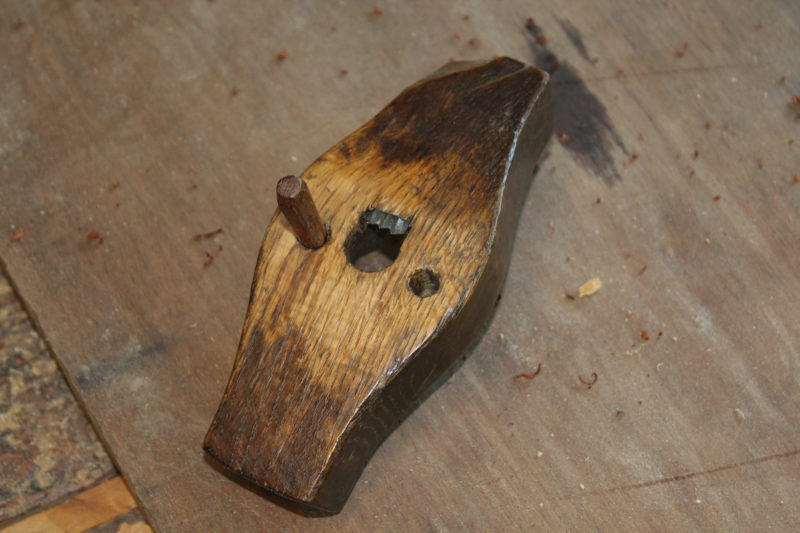
Known in Norway as a pynthøvel (pynt=decoration; høvel=plane), the plane has a custom-made blade to cut the grooves that are the distinctive mark of boats that emerge from the Aspøya shop. The peg guides the plane along the plank edge and can be put on the other side of the blade to cut in the other direction.
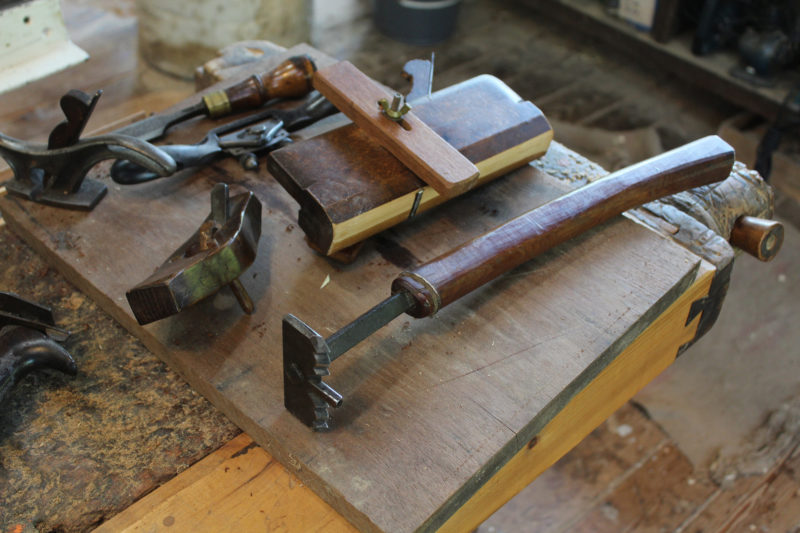
The pynt can be scraped as well as planed. The tool in the foreground, a båtstrek, has the decorative pattern duplicated on either side of a central pin that follows the edge of the plank. The tool can be used in either direction to avoid creating tear-out by working against the grain.
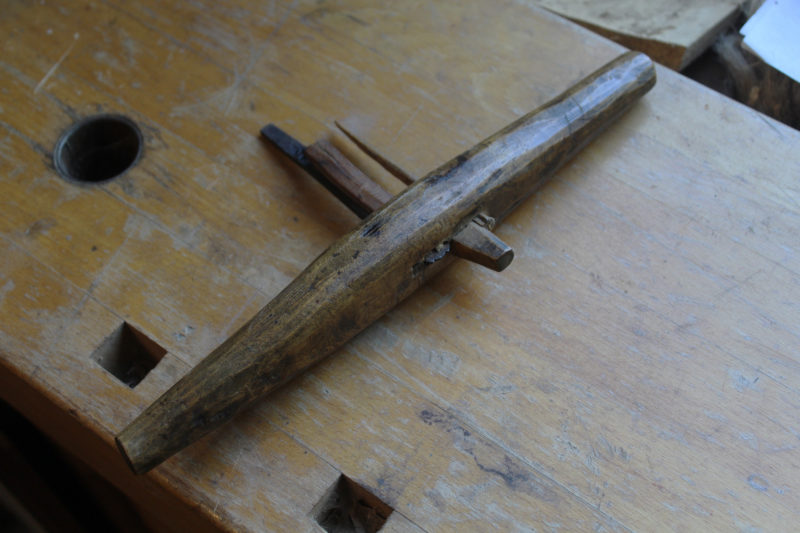
Yet another tool for creating the plank-edge pynt is this spokeshave-like scraper. This one may be nearly a century old.
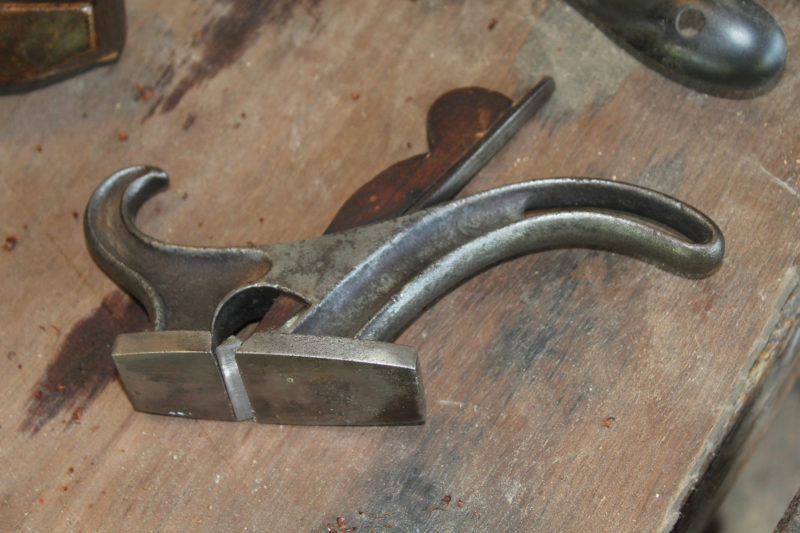
Jay found this plane at a yard sale, and didn’t know what it was designed for but couldn’t pass up buying it. The width of its sole was an exact match for the laps of the planks for VALKYRIE, his largest boatbuilding project, and with the plane’s ability to cut to the edge, it was perfect for working the gains. After a little poking around on the web, I identified the tool as a coachmaker’s plane, and this one with a narrow handle on a wider sole is a T-rabbet type.
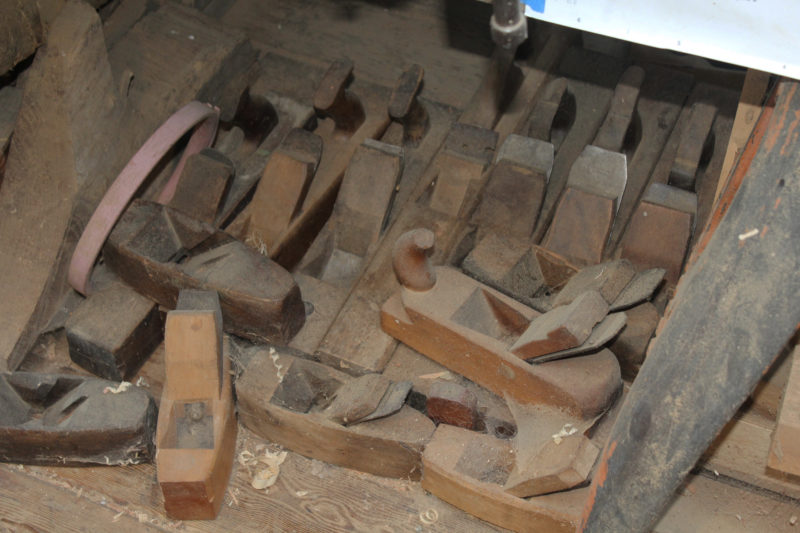
Wooden planes that don’t have places on the workbench are nested together under them, gathering cobwebs and dust.
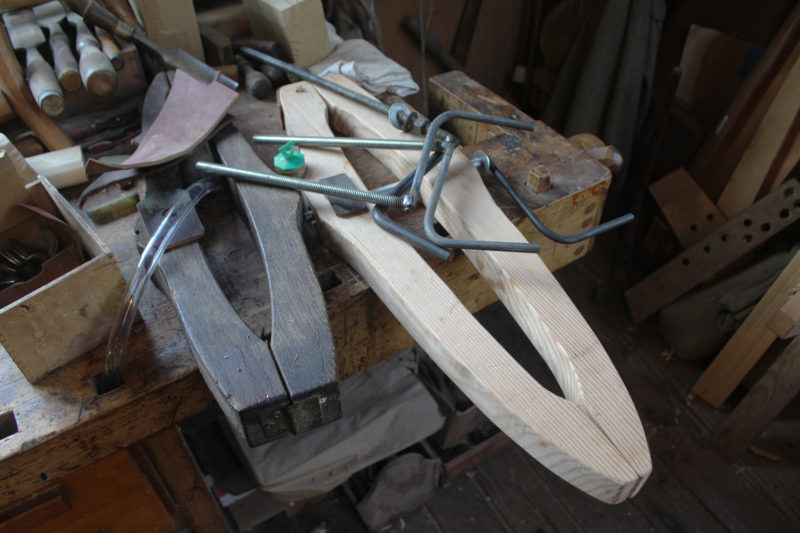
Wooden planking clamps and the parts to make them were scattered everywhere in the boatbuilding sheds and shop. The darker older clamp has a metal hinge; the new clamps use a leather strap instead. I didn’t see any of the cam-operated clamps that I’ve made for my shop, but I work with a small range of plank thicknesses, so the limited capacity of the cams isn’t an issue for me. Jay’s version with a threaded rod works as well on the faering’s planks as on his largest projects.
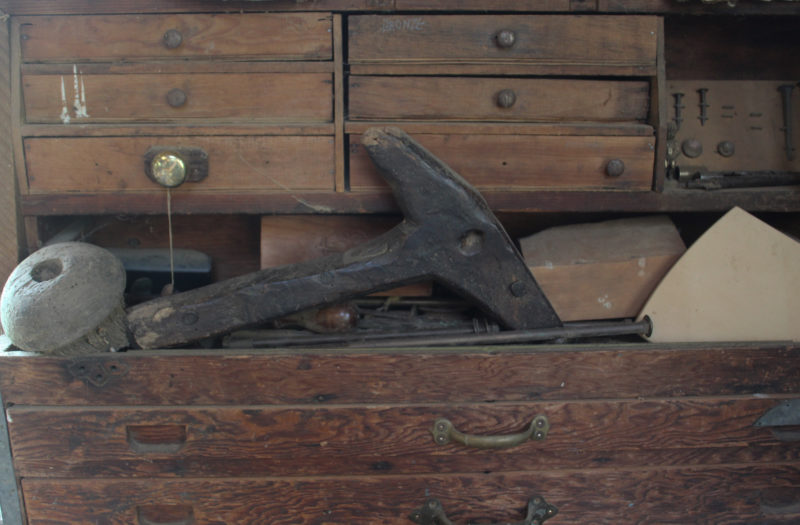
There were several old traditional oarlocks that Jay had collected in Norway. Called kjeip (or kjæppa in dialect), these are cut from a tree trunk and branch, with the trunk providing the near-vertical pin the oar pulls against and the branch fastened at the sheerline.
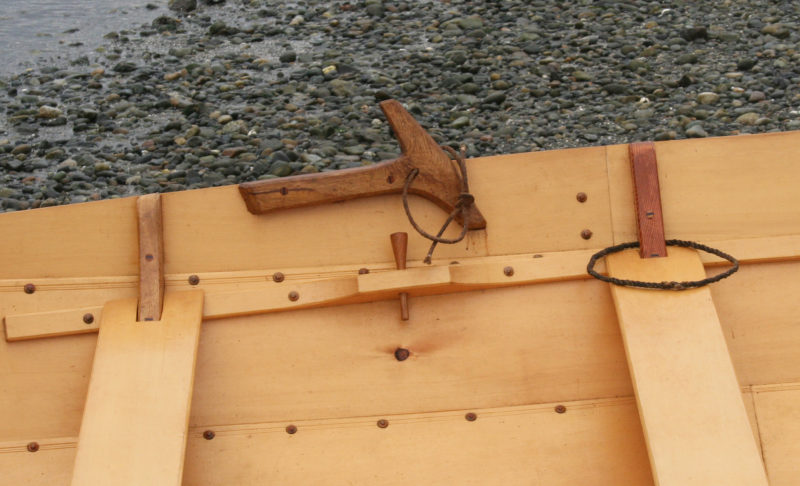
This kjeip or oarlock on the geitbåt, is fastened at the sheer with two trunnels that connect it to the sheer plank and the outwale. A third trunnel connects the kjeip with the sheer plank alone. The grommet holds the oar loom in place at the recovery of the stroke.
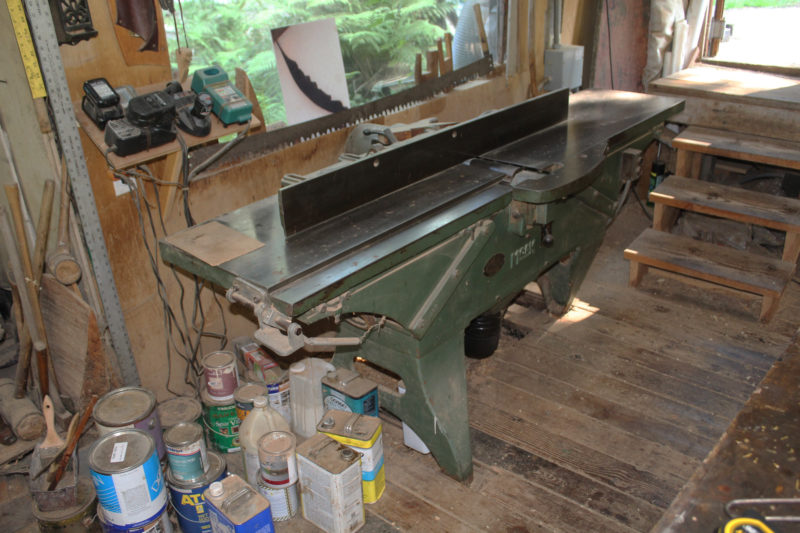
Jay’s 12″ x 7′ jointer was made by Moak Machine & Tool Company of Port Huron, Michigan. The company closed in 1992 after being in operation since 1915. The jointer was set in the east corner of the shop and long stock could be fed across the sill of the open door.
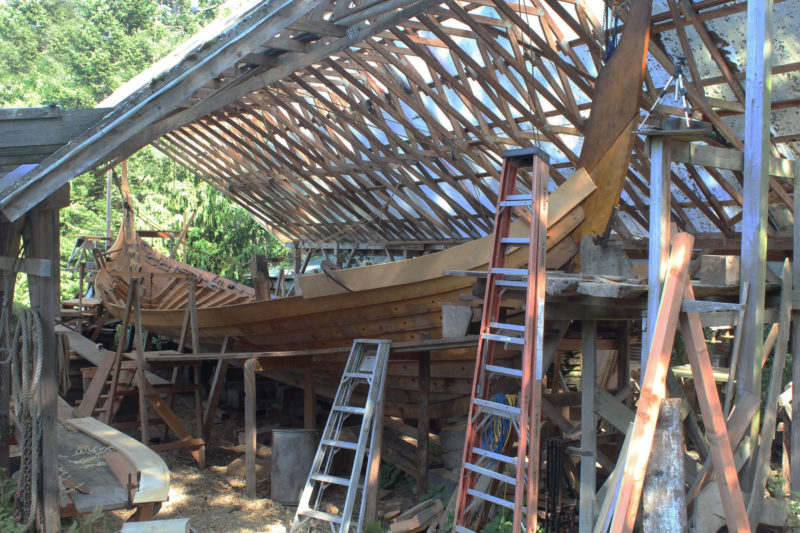
To the east of the shop is Aspøya’s biggest shed—The Pavilion. In it is VALKYRIE, a 56′ scaled-up reproduction of SKULDELEV 6, a 990-year-old 37′ fishing vessel from western Norway.
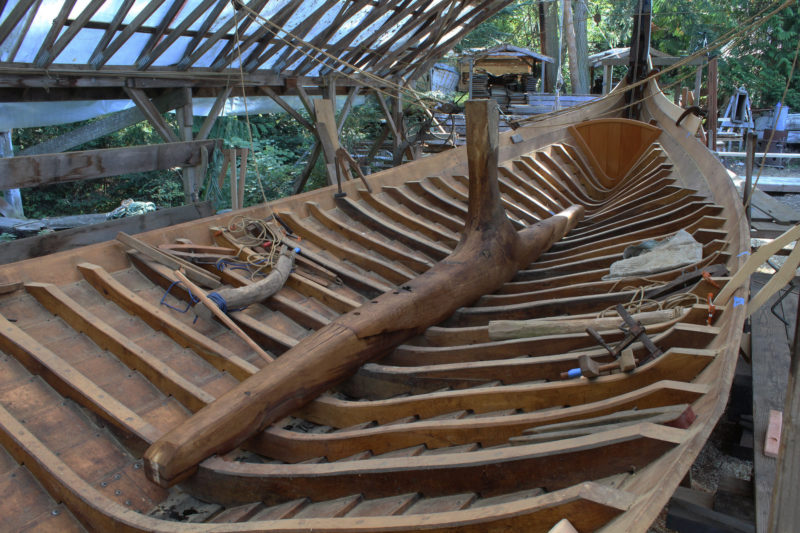
In many ways, working on the VALKYRIE is very much like working on the faering, but while it is three times longer than the Nordfjord faering, it is quite a different project because the weights involved go up by the cube of that linear scaling. The center section of the three-piece maststep, for example, is a trunk and limb from an oak tree and weighs 1,400 lbs. A similar piece, if it were part of the faering, would weigh less than 12 lbs.
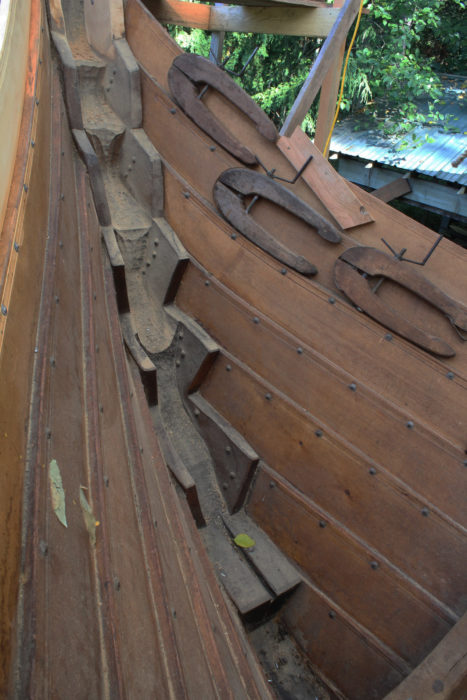
The stems of VALKYRIE have “wings” that meet the broad hood ends of the planks. I carved this type of stem on my reproduction of the Gokstad faering. There were only three strakes to that boat and it took me two weeks just to figure out how to approach the stems and then the best part of a month to carve them.
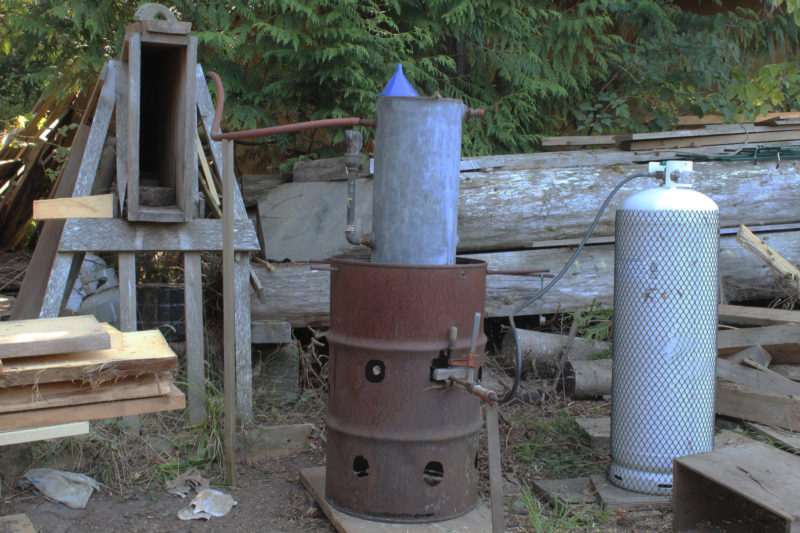
The steambox at Aspøya is propane fired and feeds a large wooden box set in the midst of all of the boatbuilding shops.
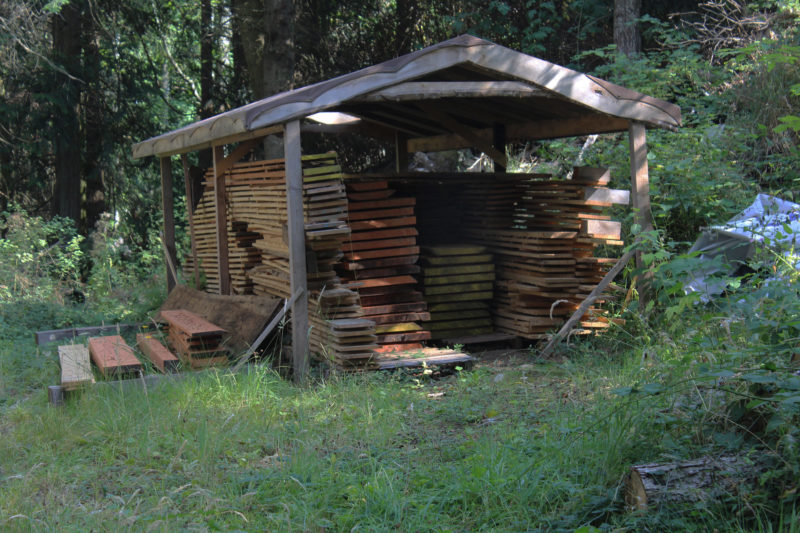
I counted four sheds built to shelter the lumber milled onsite with a portable bandsaw mill.
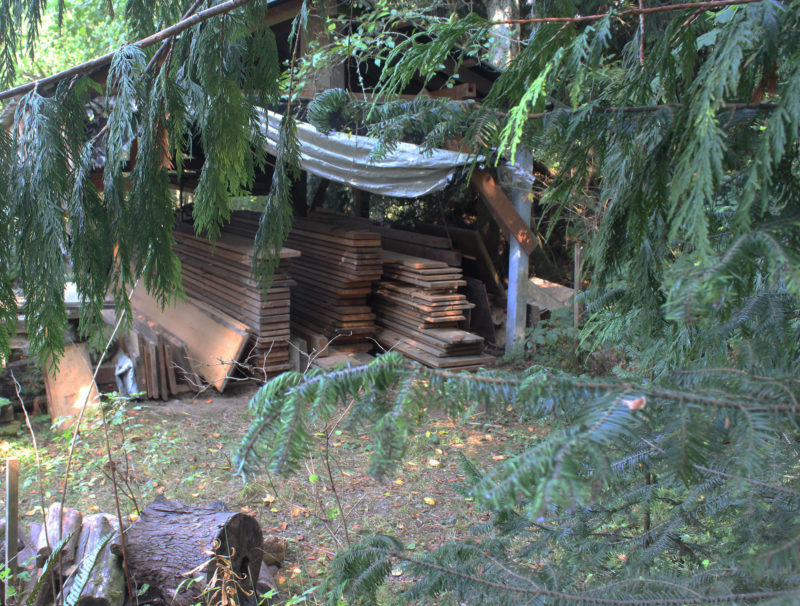
Tucked away among cedar and fir trees, another shed protects stickered stacks of lumber.
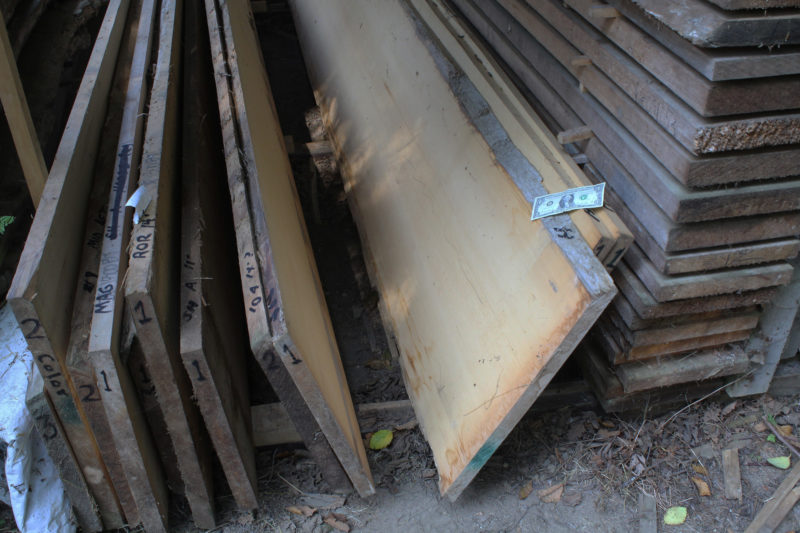
In the shed above there were some wide planks of flawless Alaskan yellow cedar. I put the dollar bill there for scale.
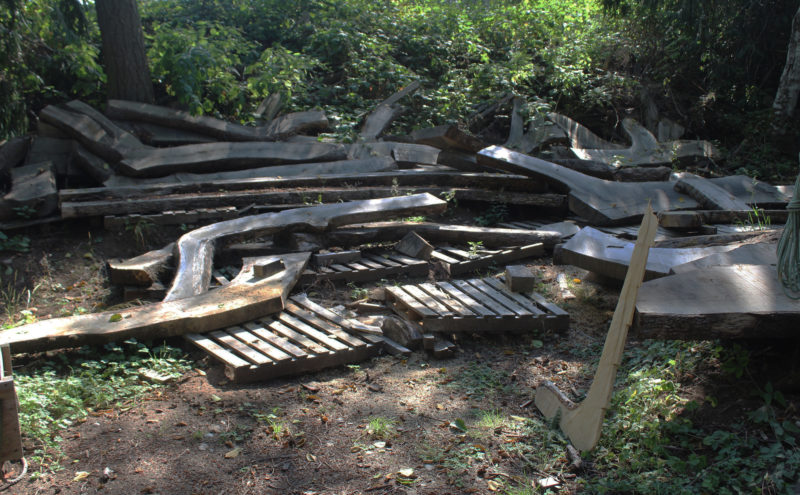
Traditional boatbuilding often required grown crooks. Jay had oak crooks piled on pallets at the edge of the brambles.
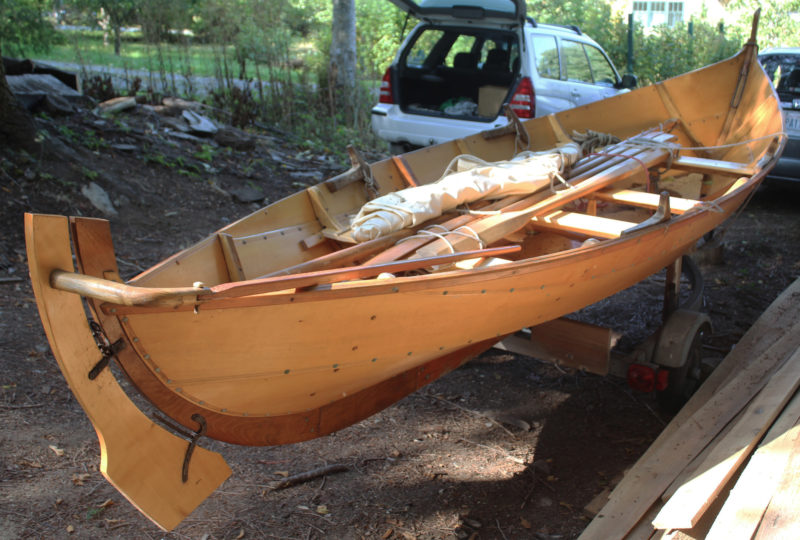
The geitbåt built by the Friday Guild in 2016 rests on a trailer near the shop that housed the Nordfjord boat project.
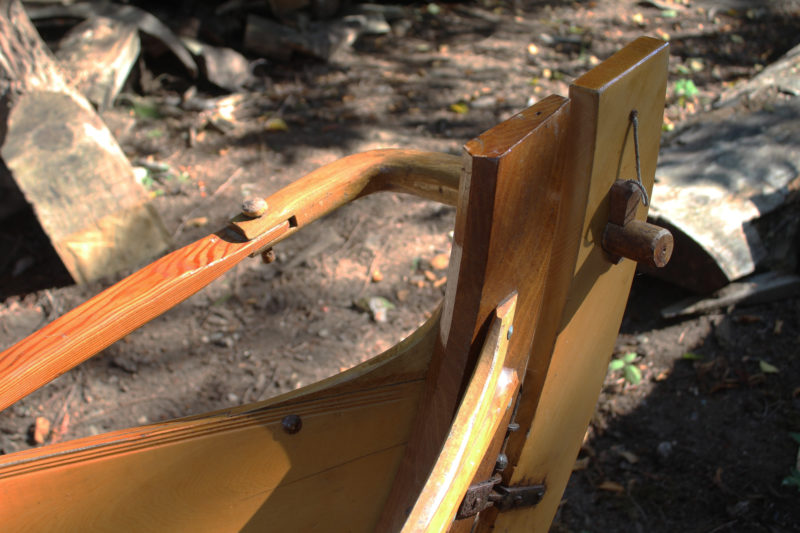
The geitbåt’s Norwegian-style tiller is made with a right-angled crook. It has a round pin through the rudderhead to provide a vertical range of motion, while a joint on its forward end allows its lateral range.
Share this article
Join The Conversation
We welcome your comments about this article. If you’d like to include a photo or a video with your comment, please email the file or link.
Comments (6)
Wow! This is a wood lover and boat lover and tradition lover’s version of heaven. So much to admire here. Thank you for showing us this amazing shop and its artisans. Wayne McCallum
I really enjoyed this. Thanks.
Incredibly authentic Norse culture alive and well in the Pacific Northwest. I guess the climate boosts the health and welfare of these folk—”wink.”
Great images and detailed explanation of components and build procedure. Thank you.
As an automotive designer though, I can’t get my head around the “winged” stem……..is it carved one piece? Jim Grant Melbourne, Australia
Each winged stem is carved from a single piece of wood. When I made my Gokstad faering I often wondered how the builder of the 9th-century original knew how to carve the stems. I had to figure out a way to transfer information from the lofting to the stock I needed to carve.I didn’t work from a solid block but made each stem from three pieces, carving the wings’ inside and outside surfaces before gluing the pieces together. Jay would have insight into the traditional method.
Each winged stem is carved from a single piece of wood. When I made my Gokstad faering I often wondered how the builder of the 9th-century original knew how to carve the stems. I had to figure out a way to transfer information from the lofting to the stock I needed to carve. I didn’t work from a solid block but made each stem from three pieces, carving the wings’ inside and outside surfaces before gluing the pieces together. Jay would have insight into the traditional method.
Wow. The Norwegian tiller set up…. I don’t need it now but is one of those fanciful little tidbits which will come in handy someday. There is at least one gem like this in each Small Boat Magazine. Thank you and happy and safe Thanksgiving to all.
Leave a Reply Cancel reply
Your email address will not be published. Required fields are marked *
Stay On Course
More From This Issue
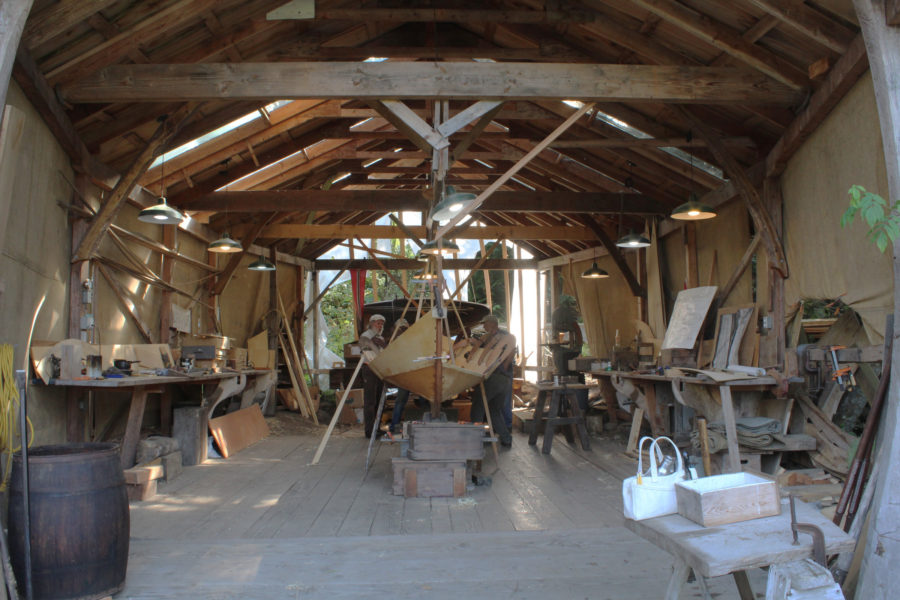
he Pacific Northwest is half a world away from Scandinavia, and the Vikings never reached it on their voyages to North America, but their influence on contemporary boatbuilders did. In...
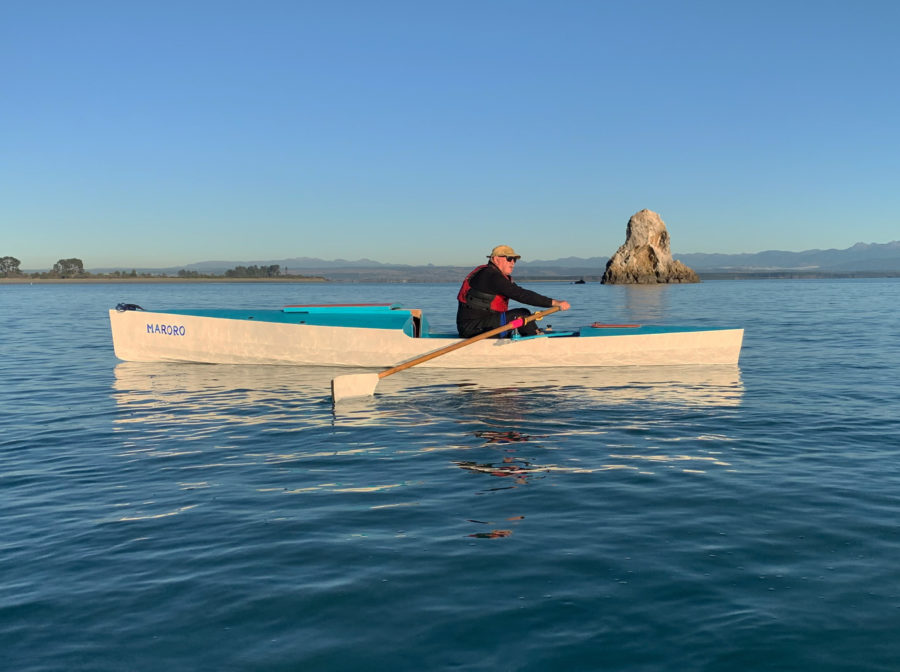
Boat Profile
The RowCruiser from Angus Boats ticked all my boxes for a solo cruiser. Its designer, Colin Angus, knows row-cruising, having traveled thousands of miles under oars. The RowCruiser is available…
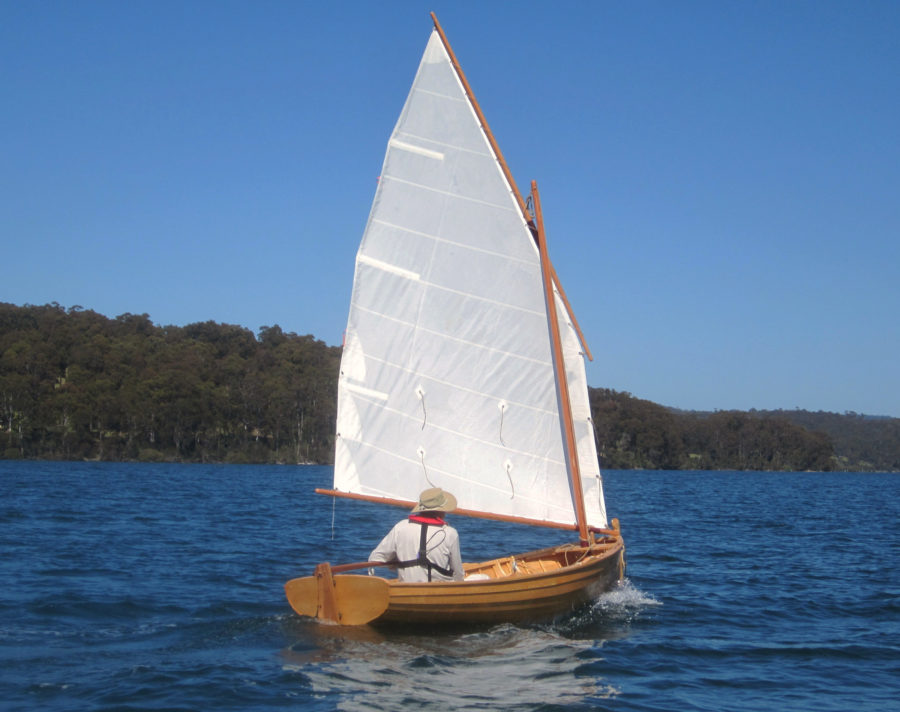
12′ Clinker Dinghy
The six pages of the plan set, available in hard and soft copy, include lines drawings with keel and stem details, offsets, construction drawings with scantlings and fastenings, stem lofting,…
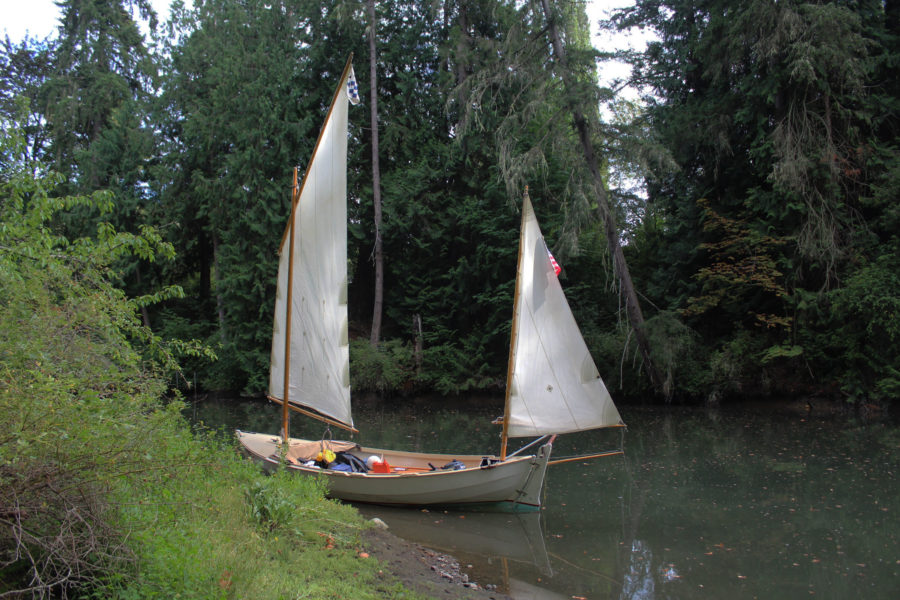
Caledonia Yawl
Bainbridge Island
While the water under the bridge was whorled but without waves, the racing current plowing under a southerly with a good 4 miles of fetch kicked a short, steep chop…
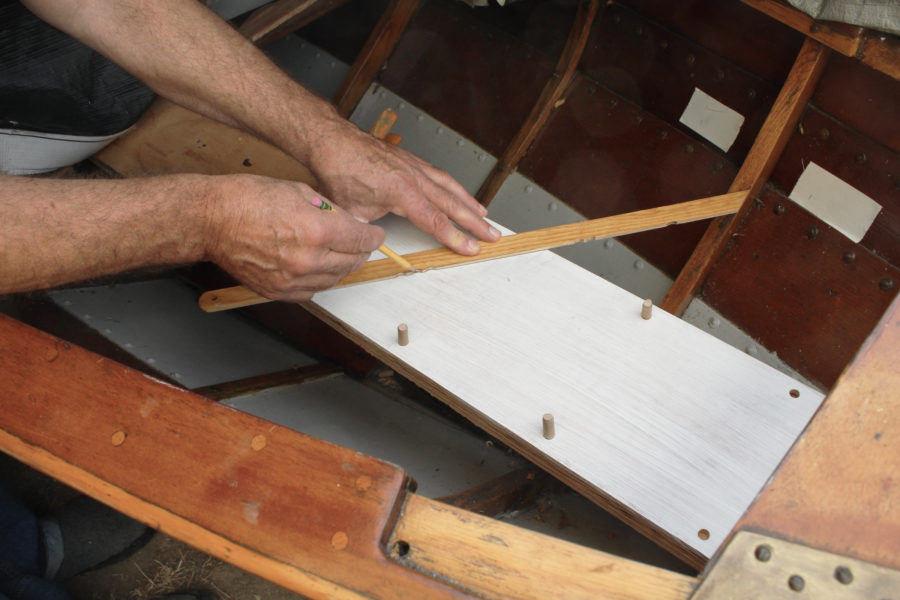
A Quick Tick Stick
I quickly traded my joggle sticks in for tick sticks. I preferred having some irregularity on the edge to register the stick without having to eyeball markings along a stick…
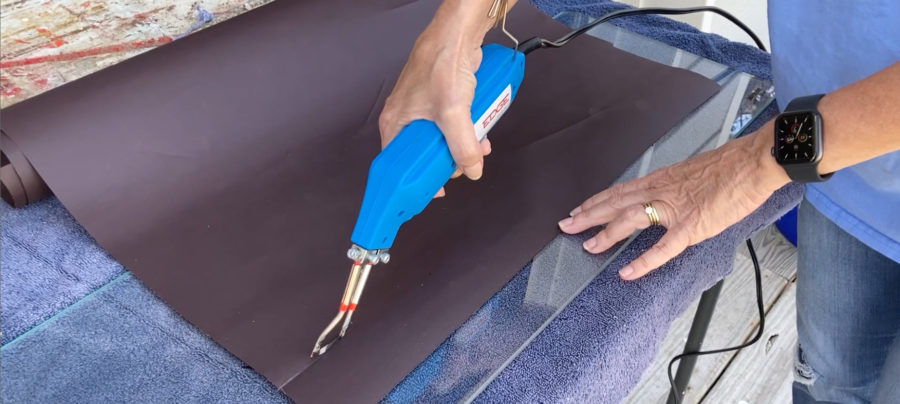
Product Reviews
Edge Hotknife
With a pull of the trigger, the blade heats up to 752 degrees F in 4 to 6 seconds and, at that temperature, a lot of material can be cut…
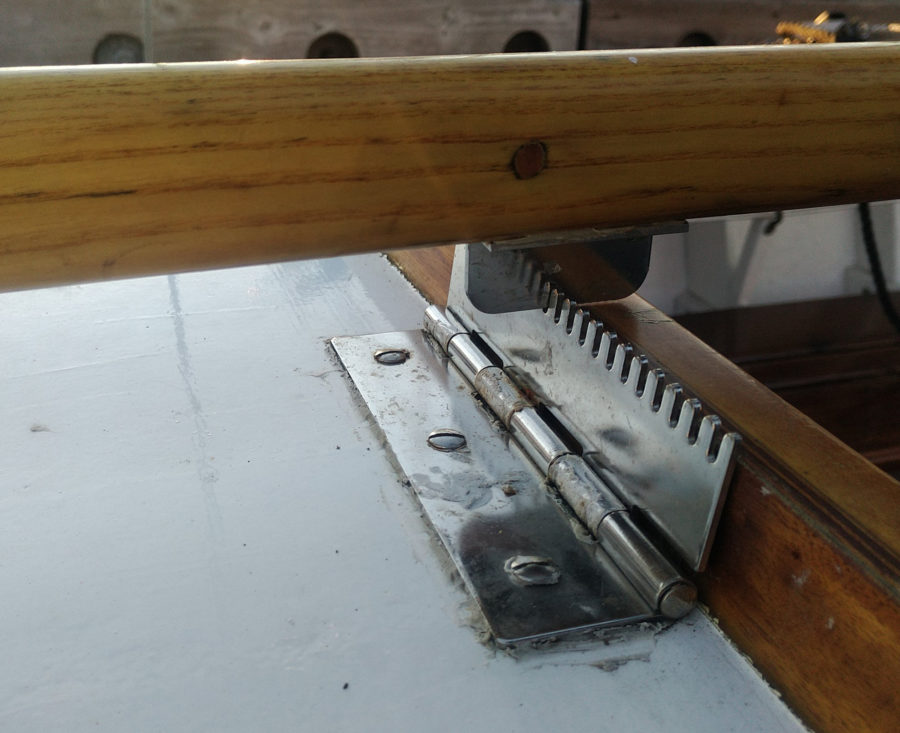
The Tiller Comb Stop
Mounting the comb closer to the rudder will increase the arc of positions it will hold the tiller in; farther away offers a more fine-grained control of where the tiller…
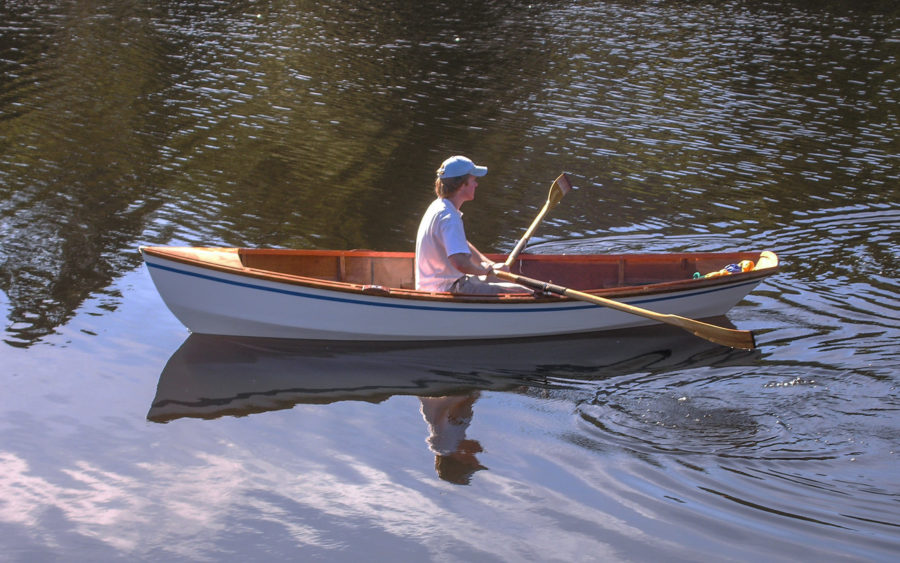
Reader Built Boats
A Kinney Dory
Dave learned that the boat had been built in Knysna by a well-respected family-run boatyard called Lucky Bean Marine. It was a 12′ dory designed in 1947 by Francis Kinney.…
More From The Editor
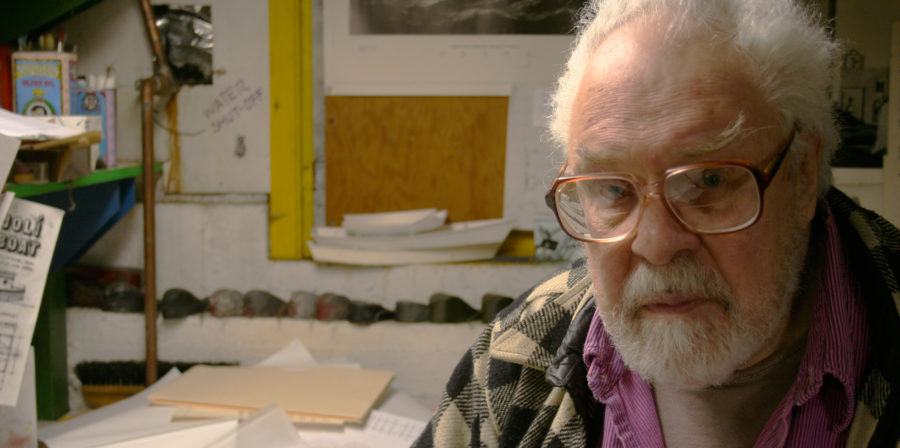
Phil Thiel’s Workshop
Sitting on ledge near the drafting table is a stack of paper models: a tombstone-transom dory at left and a double ender sitting in a pram. The two at the…
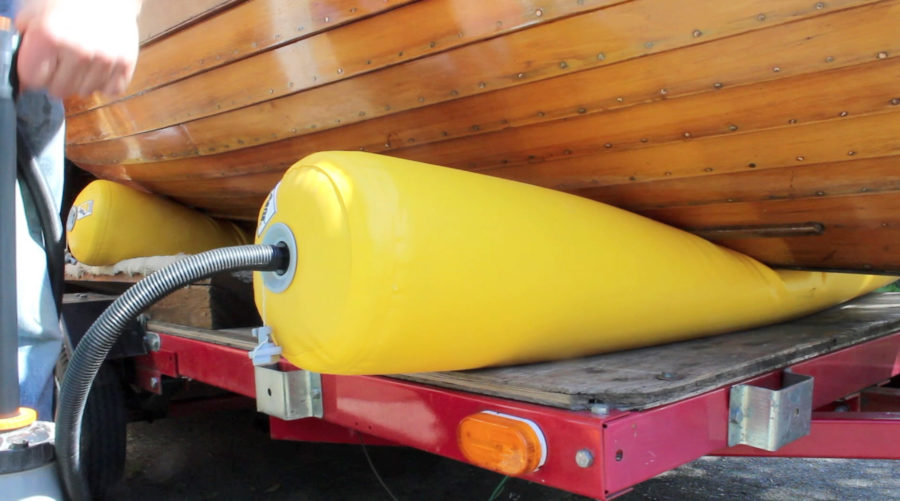
I needed to pull the centerboard out of my Whitehall and make it a bit thinner so it would operate more smoothly. I wasn’t looking forward to dragging the boat off...
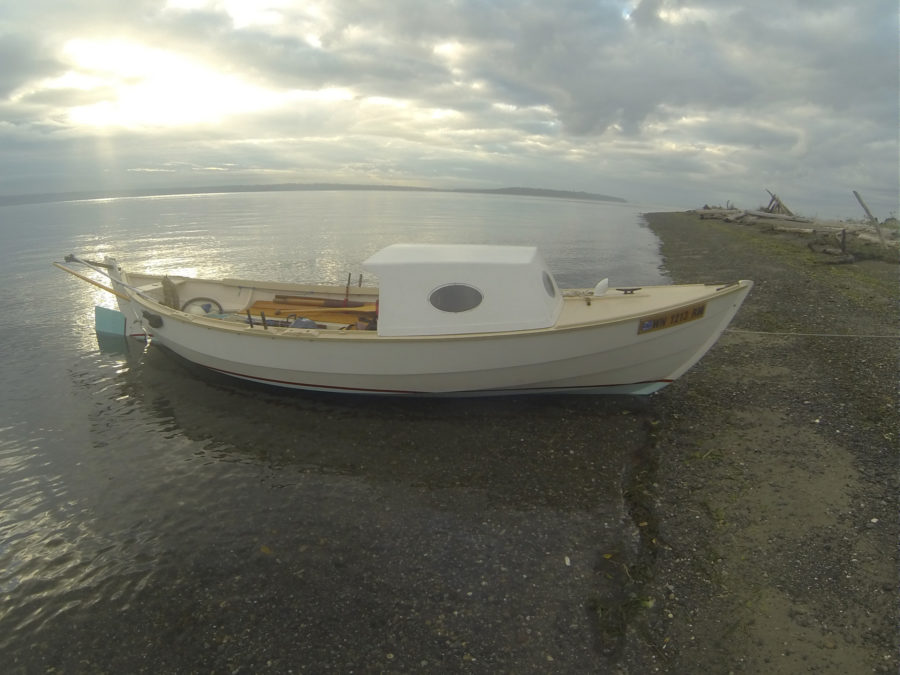
Gimme Shelter
In 2004, my kids, then 14 and 11, and I decided a Caledonia yawl was the boat we needed for cruising. While I was building the hull I revised the plans to…
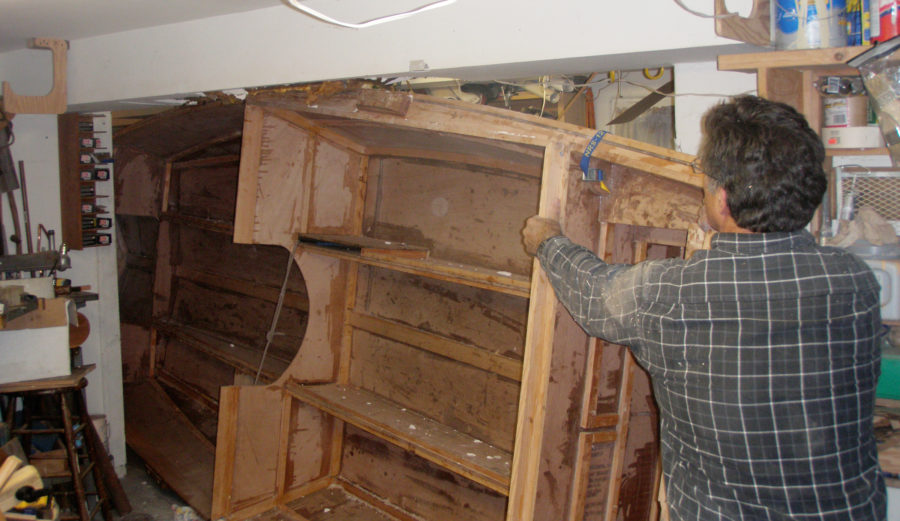
Ron Frenette of Canadian Canoes emailed me after he’d seen the Dragonfly rowing shell featured as the Reader Built Boat in our January issue. He elaborated on the reasons the...
Subscribe Today!
Become a subscriber today and you’ll recieve a new issue every month plus unlimited access to our full archive of backlogged issues.
Already a subscriber? Sign In
Subscribe For Full Access
Flipbooks are available to paid subscribers only. Subscribe now or log in for access.

“NorseBoats…sexy looking with a sweet sheerline and a shapely bow profile.” Robert Perry, naval architect
“I have Viking blood in my veins, and the NorseBoat really gets it stirring…this is one of the best small cruising boats I’ve seen in a long time.” Steve Isaac, WaterTribe
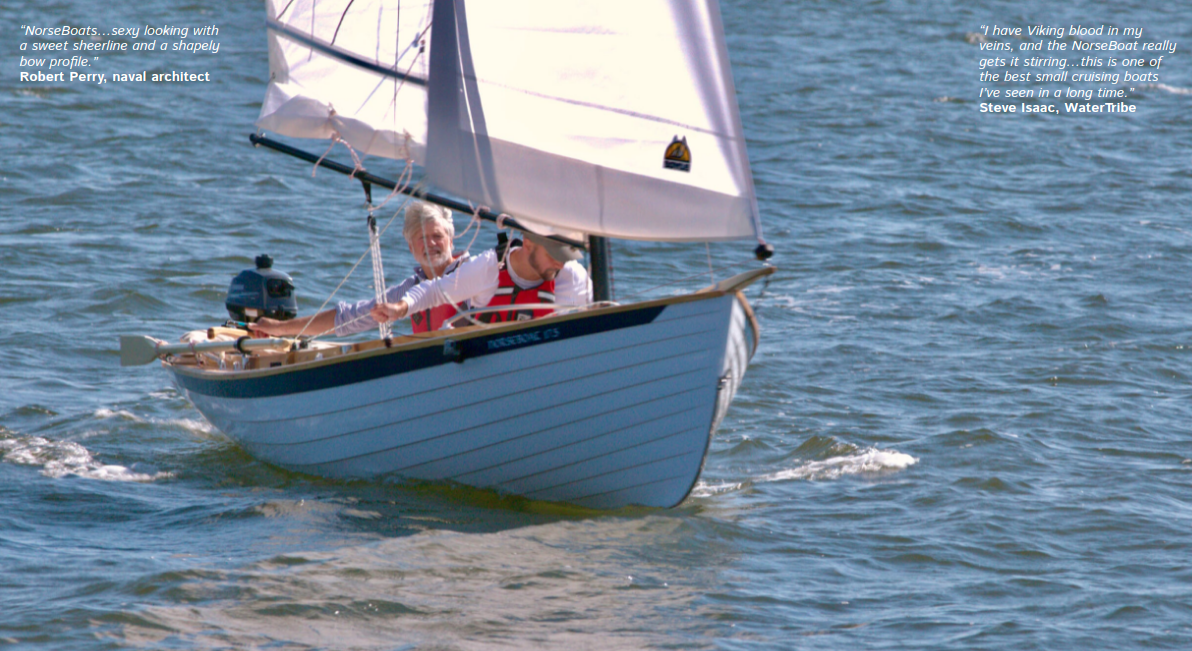
Swiss army knife craftsmanship, performance, versatility
Perfect for:
Adventuring

“The simplicity of hauling up the mast is something I hadn’t anticipated. It is yet another piece of elegant and thoughtful engineering. Truly everywhere one looks on the boat one sees careful decisions that were made. And the boat is also just so pretty. We got three sincere complements In her lines just at the docks!! In short I’m so impressed by what you have created.” C. Gill, Lincoln, MA (NorseBoat 17.5 Classic owner).
NorseBoats are hand-crafted sailing and rowing boats with classic lines and high performance. They are fast, fun and easy to use under sail or oar. Their versatility and innovative features have earned them the reputation of the Swiss army knife of boats!
NorseBoats can be sailed, rowed, motored, and used as comfortable camp-cruisers or picnic motor launches. They are easily beached and trailered, and fit in a standard garage.
NorseBoat 12.5
Daysailer / Tender Sassy sistership!
NorseBoat 17.5 Classic
Sailing & Rowing Cruiser Our best seller!
NorseBoat 21.5
Daysailer/Coastal Cruiser High capacity, high performance!
“The NorseBoat is fantastic – meeting and exceeding my expectations, which were derived solely from the internet!” J. Austin, architect, Cambridge, MA


IMAGES
VIDEO
COMMENTS
Faerings are very fine-ended, which gives them their wonderful speed and tracking. The fine ends rob the boat of flotation, however, so a 15- or 16-foot faering would have a disappointing payload. My 19'8" faering has a useful capacity of about 800 pounds, good enough for a daysailing family, or for serious camp-cruising.
Written by Matthew P. Murphy. John C. Harris. John C. Harris of Chesapeake Light Craft designed the Faering Cruiser for a client who had three firm requirements for his coastal voyager: The boat had to sail, its auxiliary power had to be provided by sliding-seat rowing, and it had to have sleeping accommodations beneath the deck.
A faering is an open boat with two pairs of oars, commonly found in most boat-building traditions in western and northern Scandinavia. History. Faerings are clinker-built, with planks overlapped and riveted together to form the hull. This ...
The word Faering refers to the four oar stations. It merely means a boat with 4 oars. In the same way a treroring has 3 rowing in the boat.There are also larger and smaller row boats in the same tradition. Different areas have variations of faerings, but they all have 4 oars in common. A faering is a clinker (lapstrake) type boat which is ...
W hen my parents returned home to Edmonds, Washington, from a trip to England in 1983 they brought me two green booklets about the Gokstad faering, the smallest of three ninth-century boats unearthed along with the Gokstad ship in 1880 near Norway's Oslo Fjord. The 21′ faering was the most beautiful boat I had ever seen, and I wanted to build a replica of it.
The Gokstad faering. The original two smaller boats found together with the Gokstad ship. These are 1100 years old! Færing from Sunnmøre during building in the workshop of Jakob S. Bjørkedal. My own færing before I purchased it. Built ca 1960 in Bjørkedalen. Price about 850 $ in 2004. Not a very elegant boat, but it is very light.
Kari 24' Norwegian Faering Particulars. LOA: 24' 2 1/2" 7.38m: Beam: 7' 1 1/2" 2.17m: Draft (loaded) 1' 10" 0.55m: Hull Mid Depth: 1' 11" 0.59m: Displacement to WL ... were asked to develop the plank shapes for a replica of a 4 oared Faering from some lines that had been taken off the boat some while back. The client was the husband of the ...
The elegant hull shape of the Norwegian faering adapts well to the modern stitch-and-glue method, in which pre-fabricated plywood panels are joined at their edges to create a light and stiff hull with minimal framing. Boat designer John Harris created a 19′8″ stitch-and-glue faering for beach cruising with one or two sliding-seat rowers.
The boat is currently stored indoors at Chesapeake Light Craft in Annapolis, available for your inspection. The Faering Cruiser was designed for singlehanded coastal cruising. The Maine Island Trail, the various WaterTribe courses, and thousands of miles of accessible rivers and estuaries are the Faering Cruiser's natural haunts.
By 1890, the writing was on the wall for the open-boat Lofoten cod fishery. That year, a massive fleet of færings and fembørings encircled a fleet of industrial steam-driven vessels in an attempt to ban their access to the 2km-long (1.24 mile) Trollfjord. The incident is recorded in a painting by the Norwegian artist Gunnar Berg, who hailed ...
Faering Cruiser. This 22' 6" Faering lugsail and rowing cruiser was designed by John Harris. Hull kits and plans for building her may be obtained from Fyne Boat Kits.*. A hull kit will set you back £3,700, but it includes most things required for building the boat, except for her sliding rowing seat, balanced lugsail, skulls, paint and ...
Re: Gokstad Faering - Design Study hello Fo-mo, great work with GF. I admire your other plans also. unfortunetly both fearings - oselvar and goksted are too long for my shop :-(but I have a question: if you would be to build boat according to lines of the boat found in the Viking grave at Arby
The faering was delivered without sails for around £3,500. Sails were made by North Sea Sails in Essex. Oars and all spars were made by Viking Boats. Morgan builds and restores wooden boats at his workshop within Leckmelm Estate Victorian farm buildings on the shores of Loch Broom. Leckmelm is 50 miles (one-hour drive) from Inverness and five ...
Ragnar Thorseth, a Norwegian adventurer, crossed the North Sea alone in a faering during the summer of 1969. Olav Lie Gundersen and Tommy Skeide repeated the feat in 2005 in a type of Norwegian faering called a geitbåt; then, after reaching Shetland, they continued the voyage and rowed all the way to the Faroe Islands.
A stretch of the 19'8" stitch-and-glue CLC Faering to 22'6" would provide space for a sliding seat amidships, a small cuddy aft, and a sailing rig forward. We were pretty excited by the early sketches, which suggested a boat that was both functional and stylish. We built the Faering Cruiser in about seven months of part-time work at CLC's ...
16′ Faering. These four boats were built for two different Viking era type TV productions. The first ones were built (2012) for Game of Thrones and feature large ceremonial stem and stern ornaments. They were built as funeral boats for a major scene. ... (2013) and were to be used as general boat transport for various characters.
12 sheets of 9mm plywood. Guidance Use. 3-4 adults. Drawing/Design Package. 6 x A1 drawings + 12 x A4 instruction sheets. Additions and alterations included with the plans. Moulds/jig for strip plank. Square sail rig. Kari 2 Faering Plans.
The boat was documented in The Inshore Craft of Norway, and when the drawings were made in 1943, the boat was reported to be over 100 years old. When the faering is finished, it will be Leah's "company yacht" for Best Coast Canvas , the maker of the Verksted Apron I reviewed this past spring.
NorseBoat 17.5 in 2002. His concept. was simple: versatile, seaworthy sailing. and rowing boats with classic lines and. high performance. Since form and. function were both important, Kevin. collaborated with Chuck Paine &. Associates in Camden, Maine to.
June 2013. Our 22'6" rowing-sailing pocket cruiser has hit the water and seems to be a great success. Read about the origins of the project here. Scroll down for the latest photos. The design was commissioned by an individual with three firm requirements for a coastal cruiser: the boat must sail, offer sliding seat rowing as auxiliary power ...
Enjoy hours of free boatbuilding video content, including this 14-part how-to that takes you through a stitch-and-glue kayak kit from start to finish. Dozens of videos on strip-planked kayaks are here, and most boat pages have engaging intro videos like this one. On this site you will find not just boat kits and plans but boatbuilding materials, marine plywood, boatbuilding tools, MAS epoxy ...
Upcoming Boat Shows. Apr 20: Sail & Sell: A Maritime Market Collective; May 18: Big Little Boat Festival 2024; Jun 28-30: WoodenBoat Show at Mystic Seaport; Sep 6-8: The Wooden Boat Festival in Port Townsend, WA; Oct 5: Mid-Atlantic Small Craft Festival; Oct 10-14: Annapolis Sailboat Show; Upcoming Classes. Mar 18-23: Sassafras Canoe (MD)